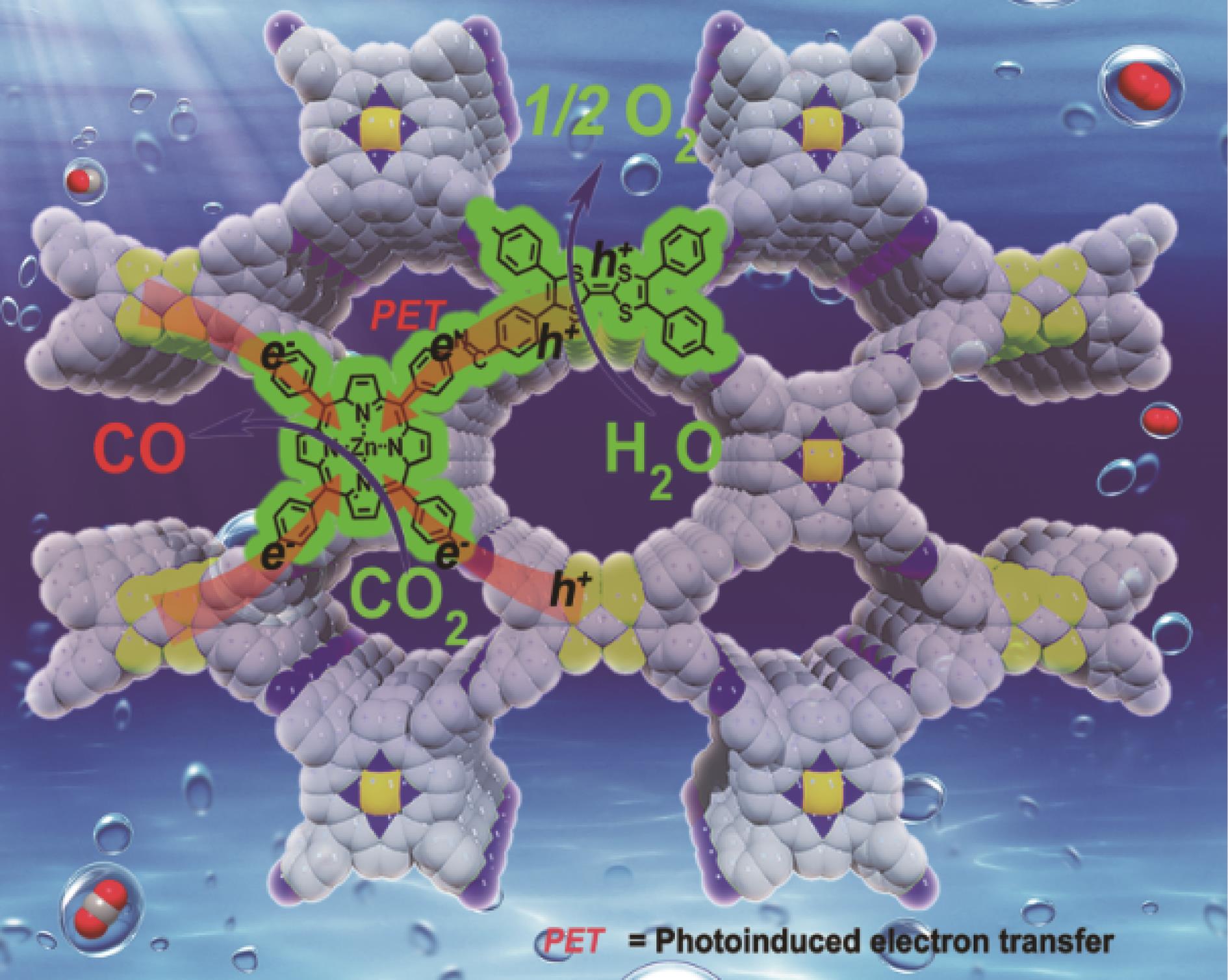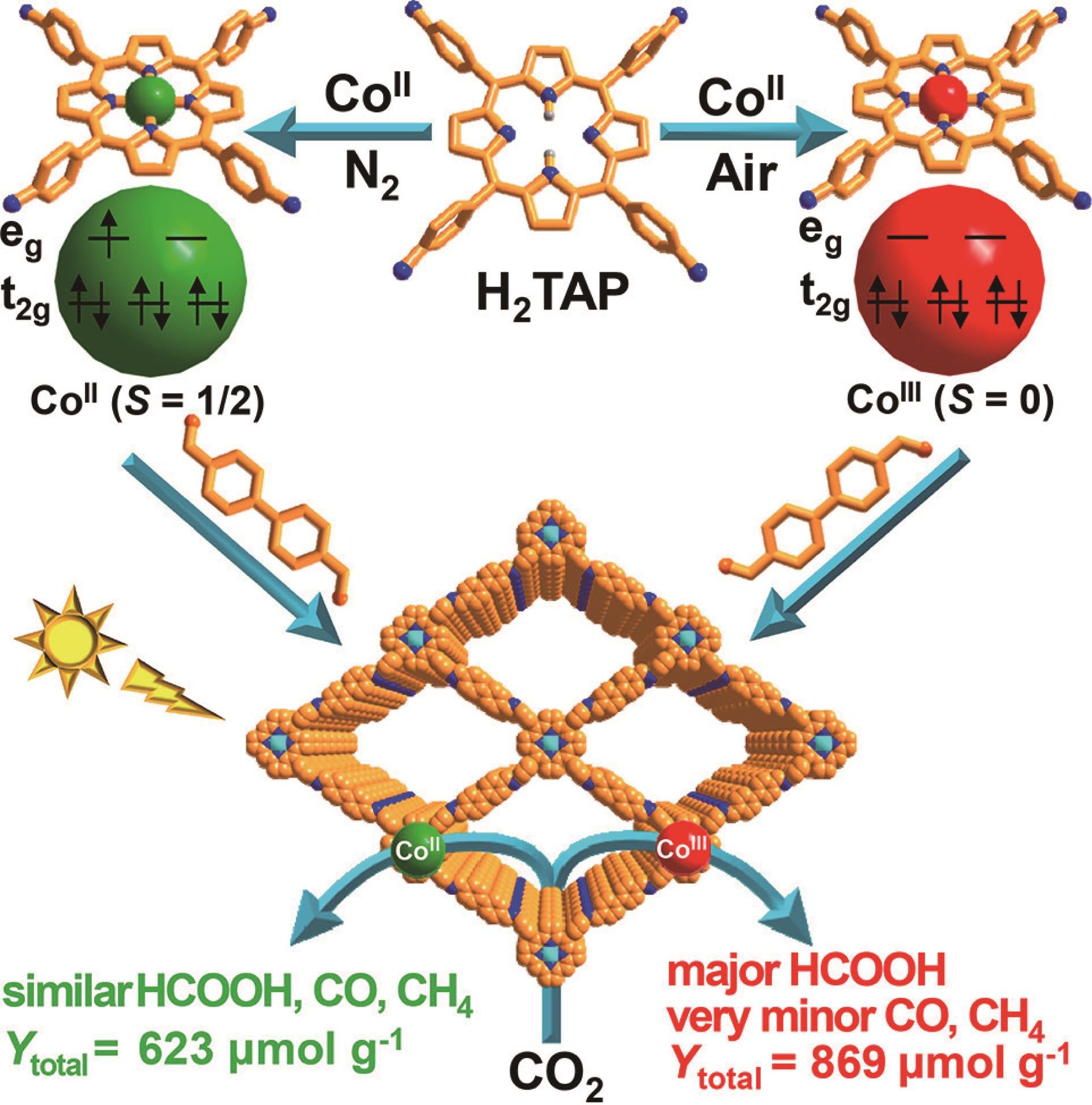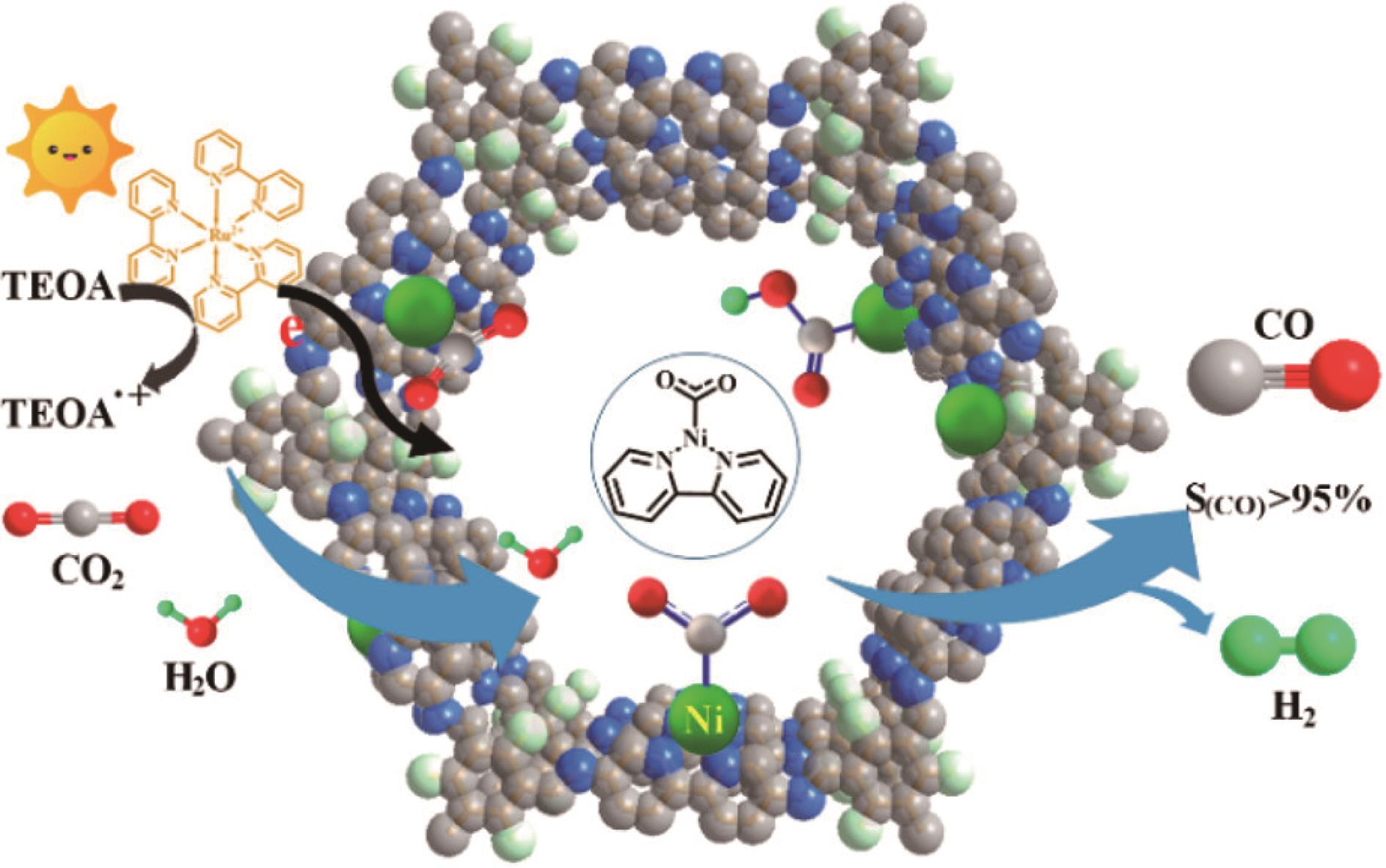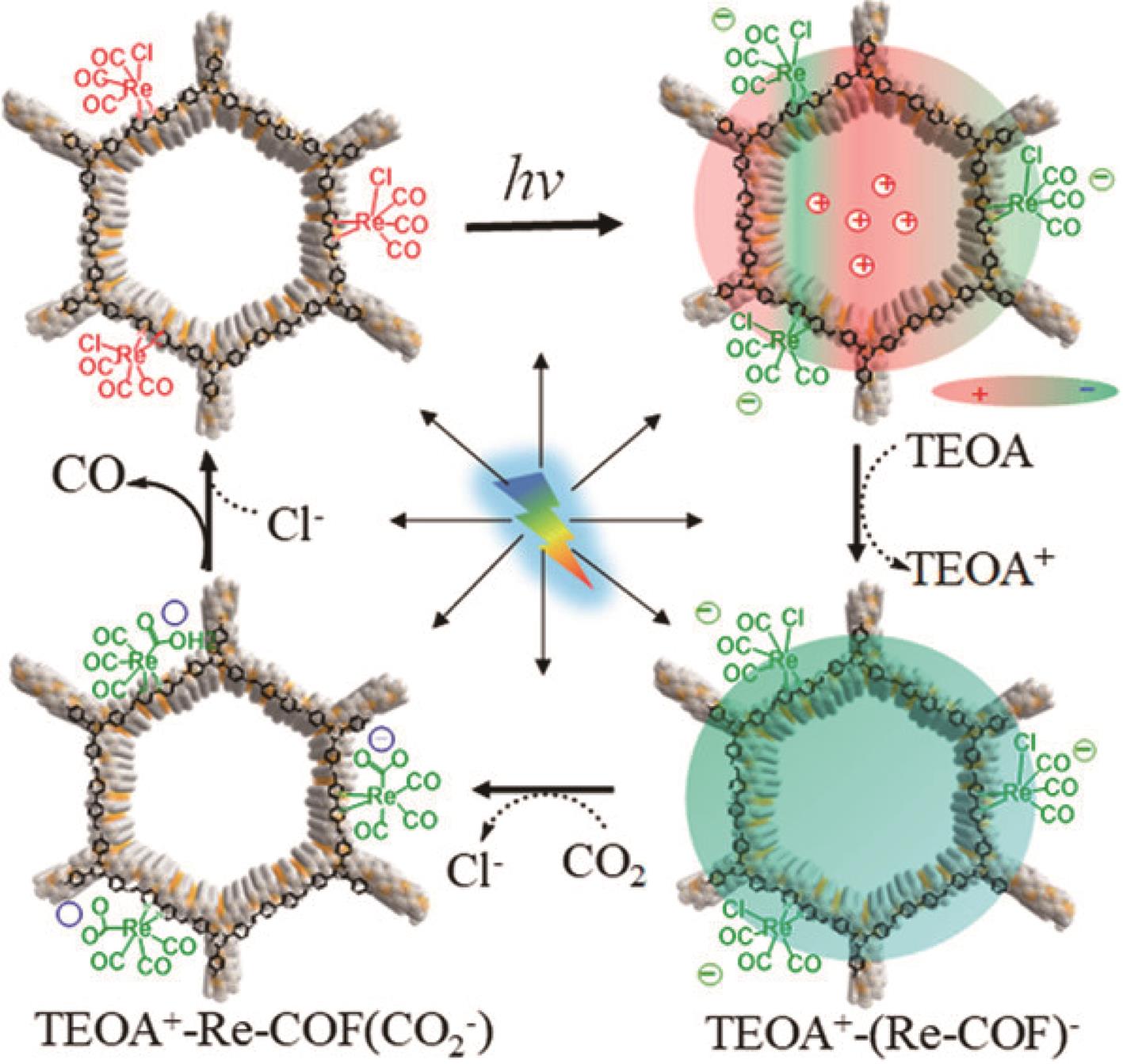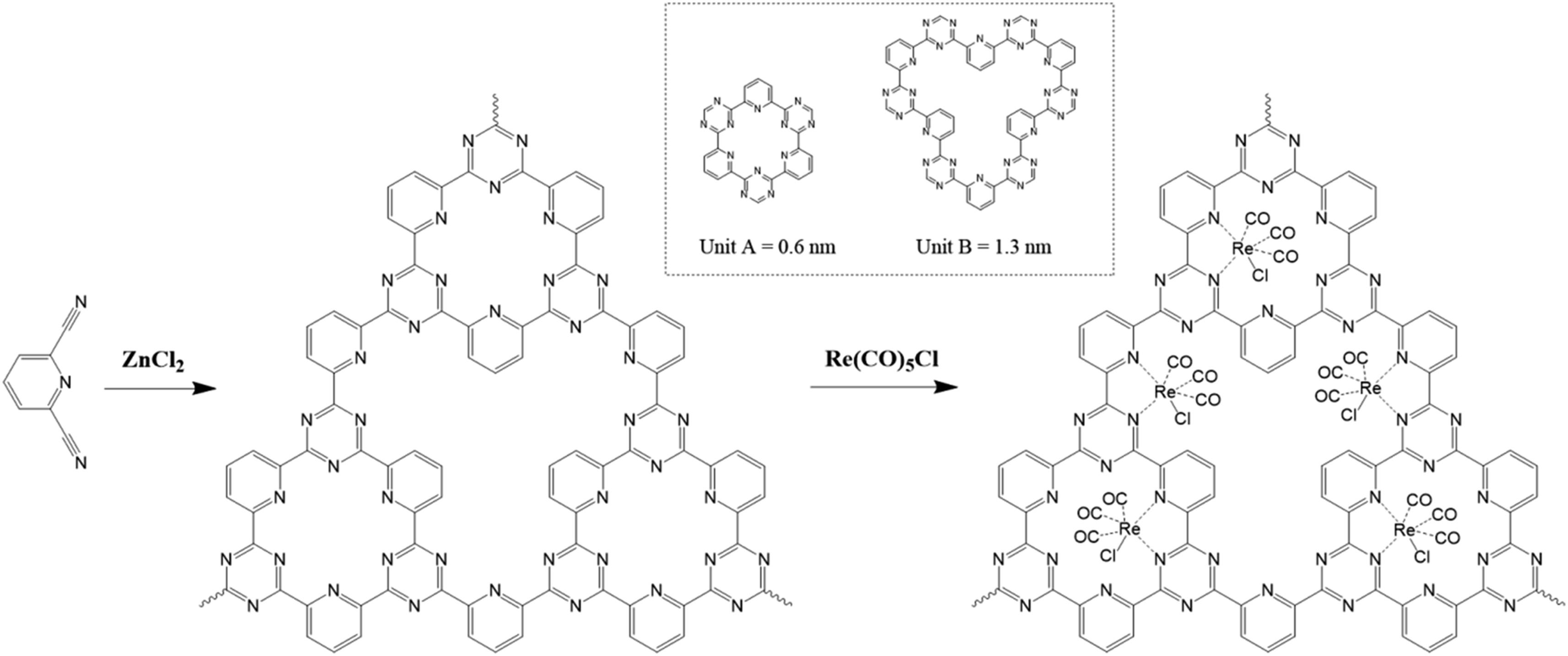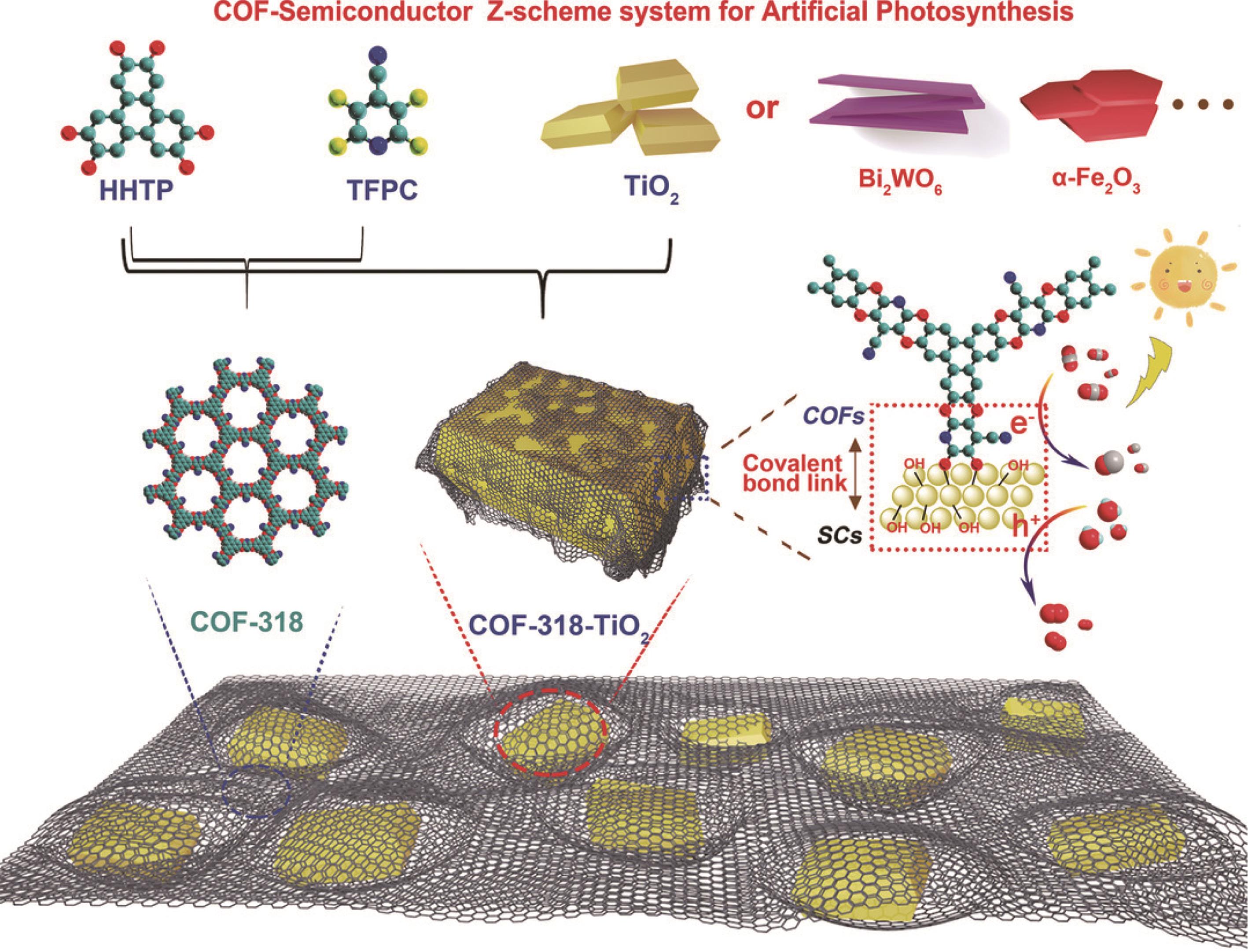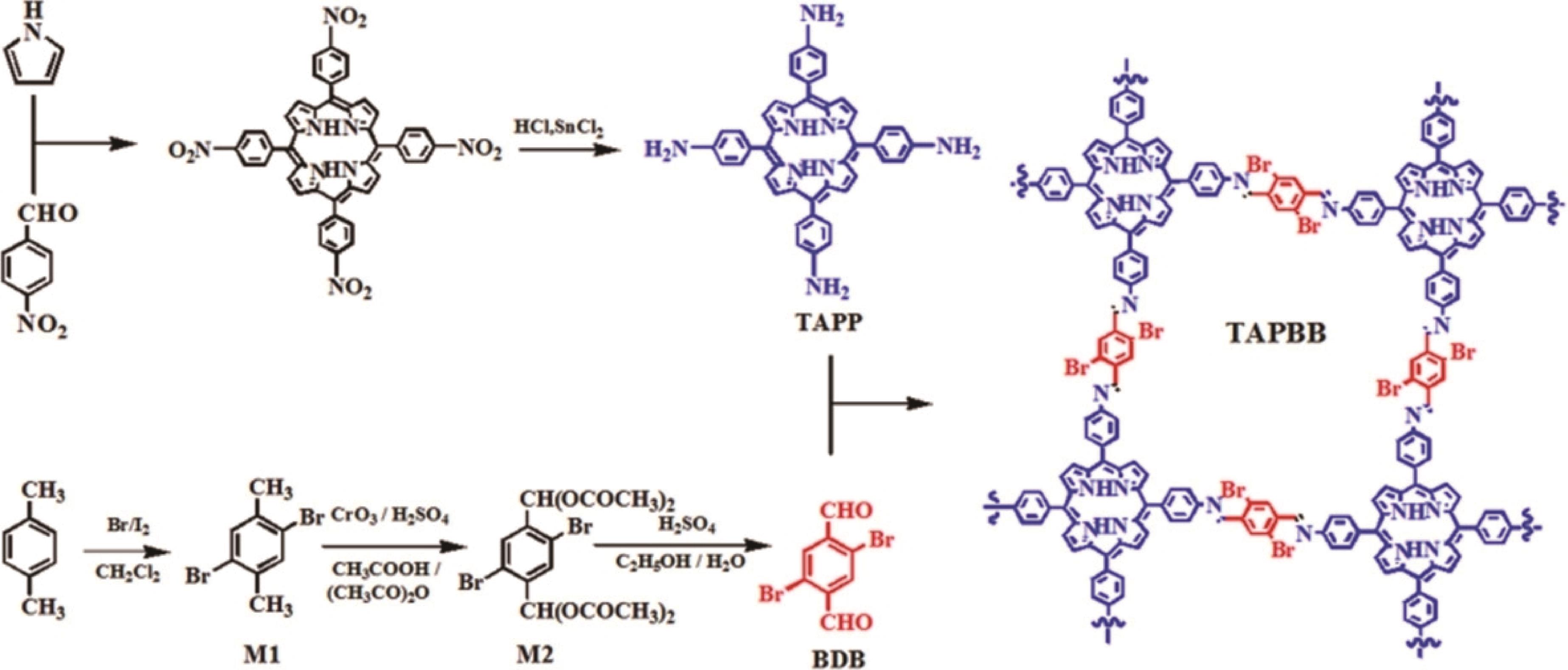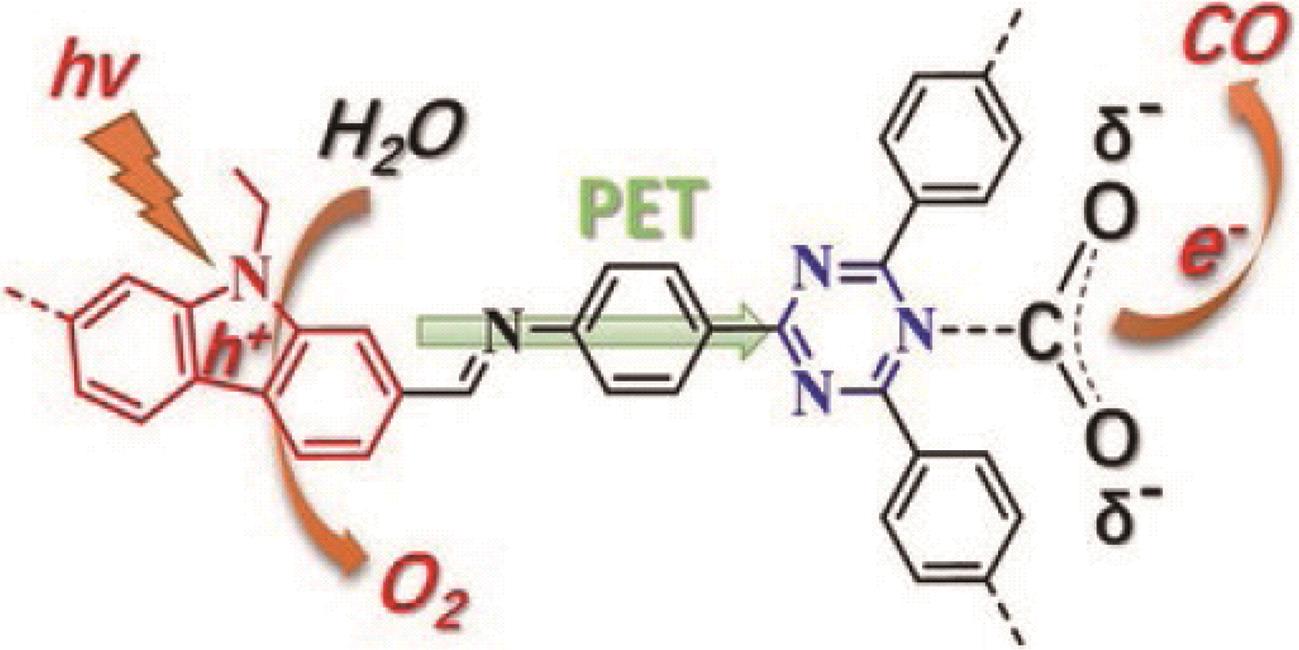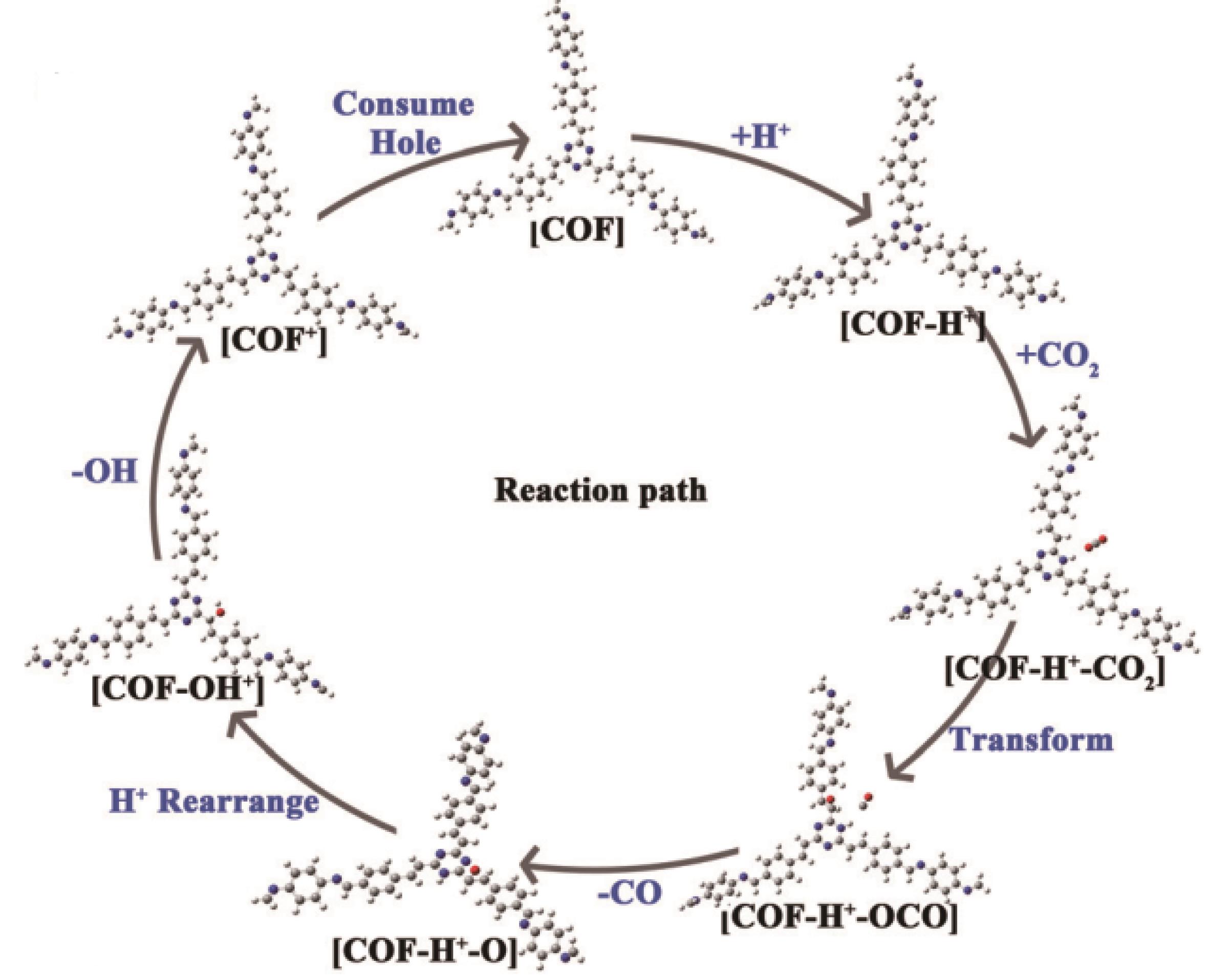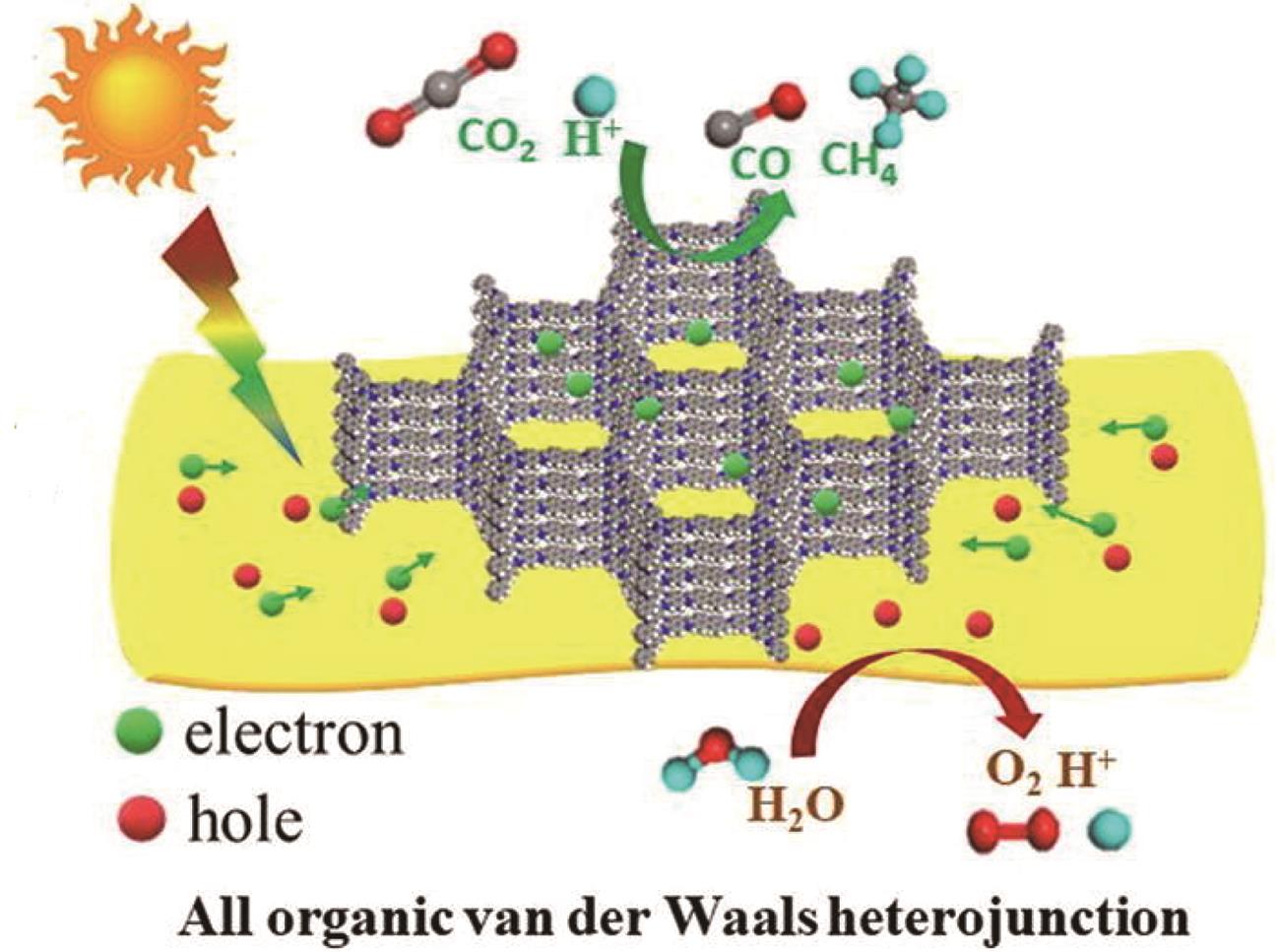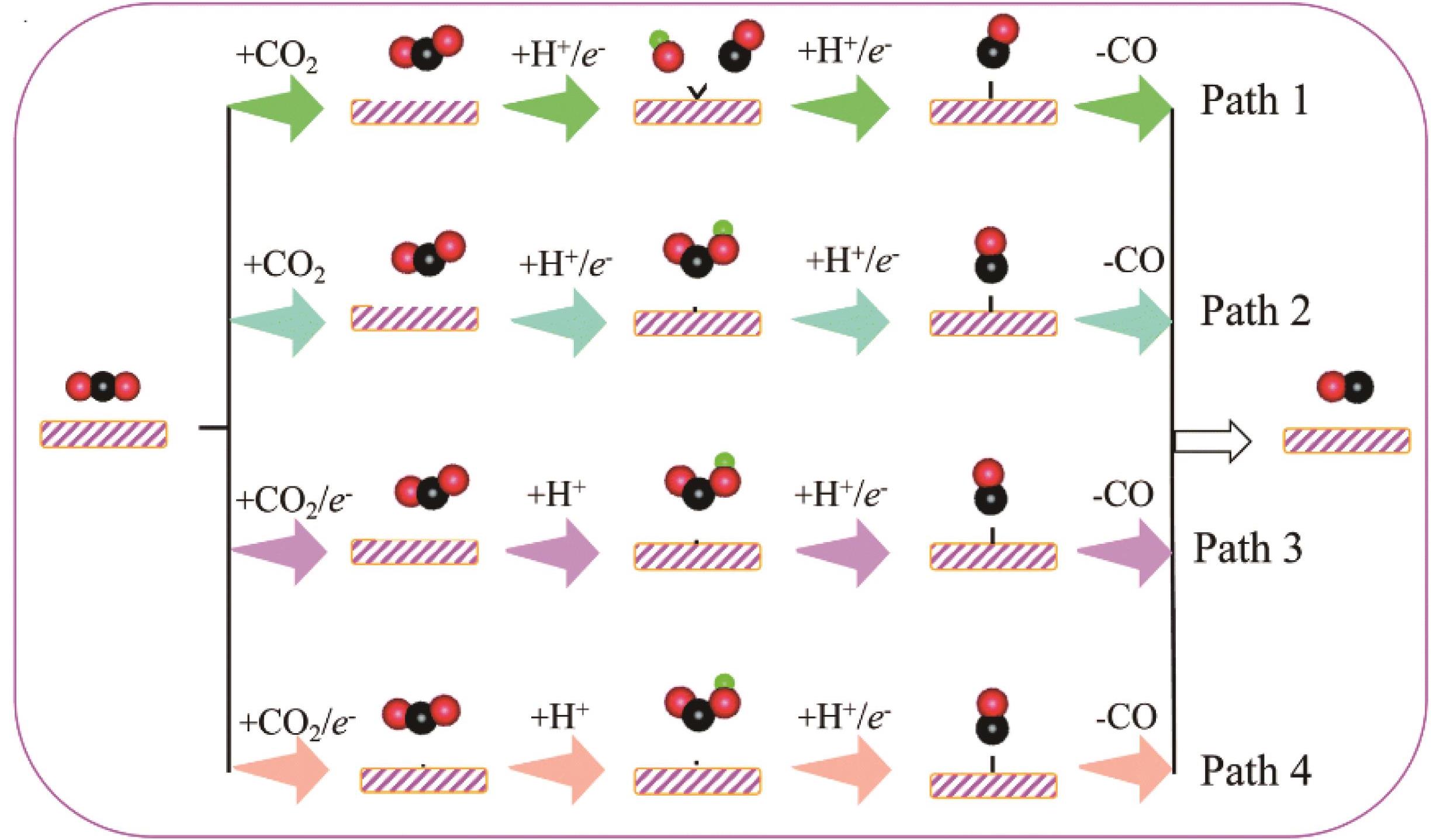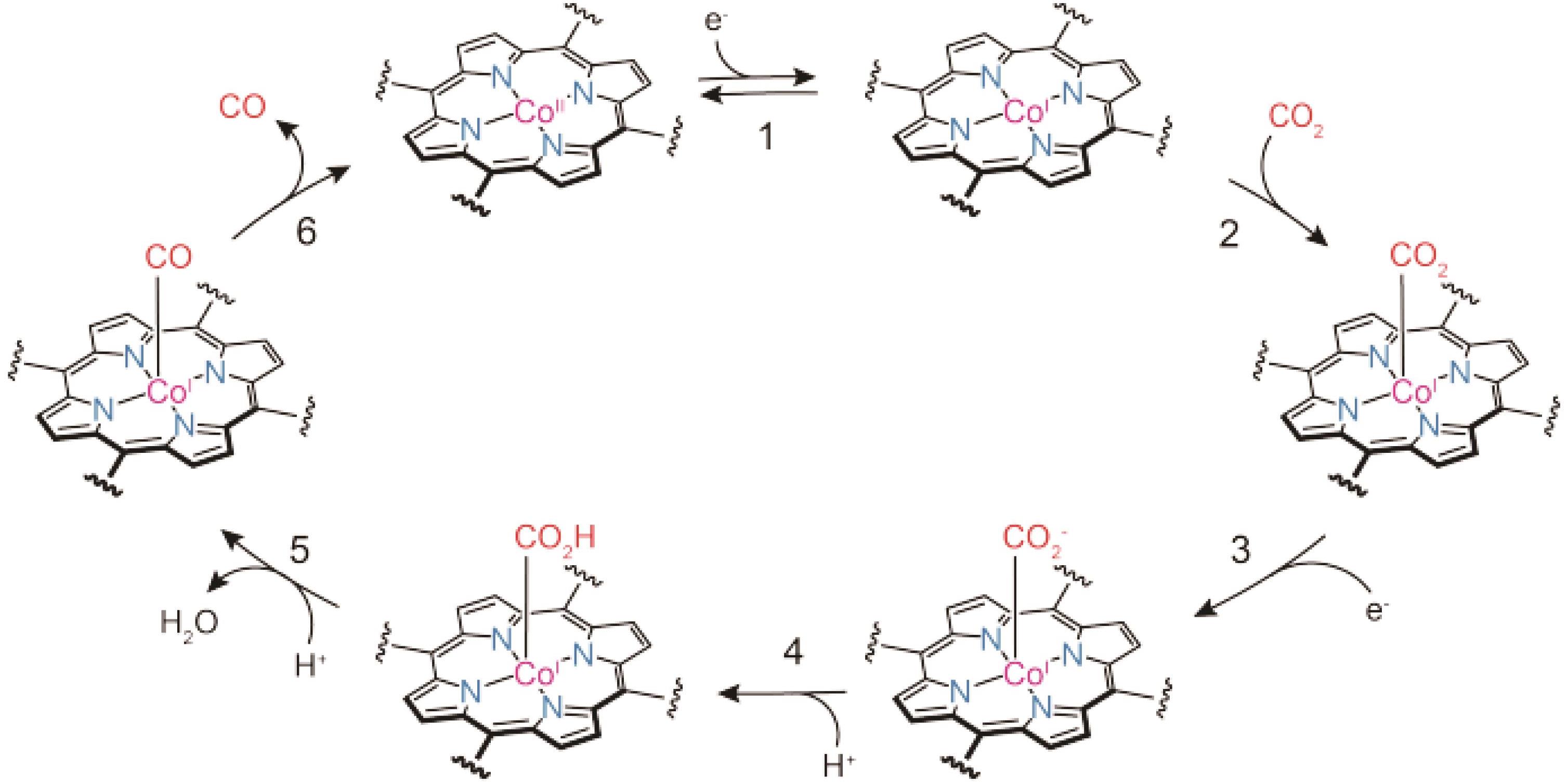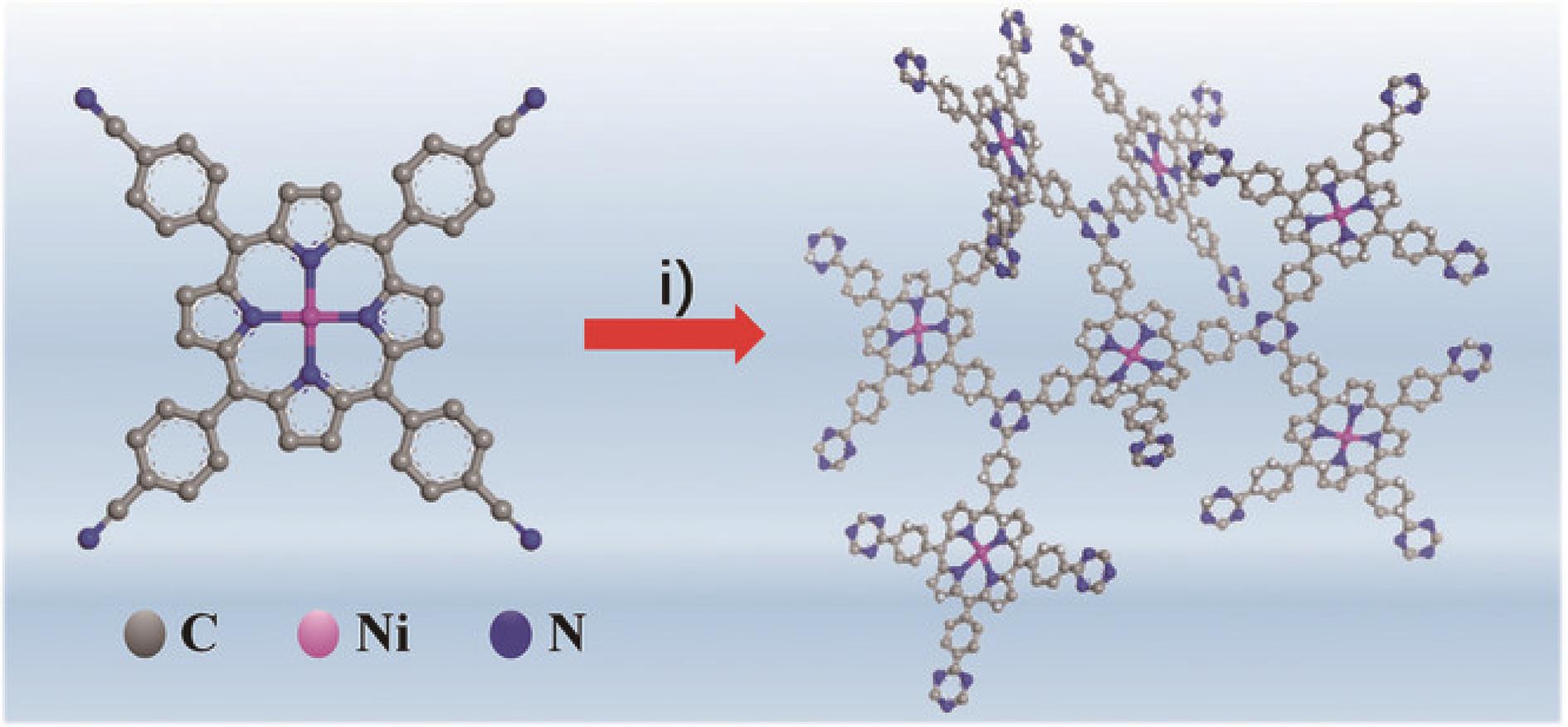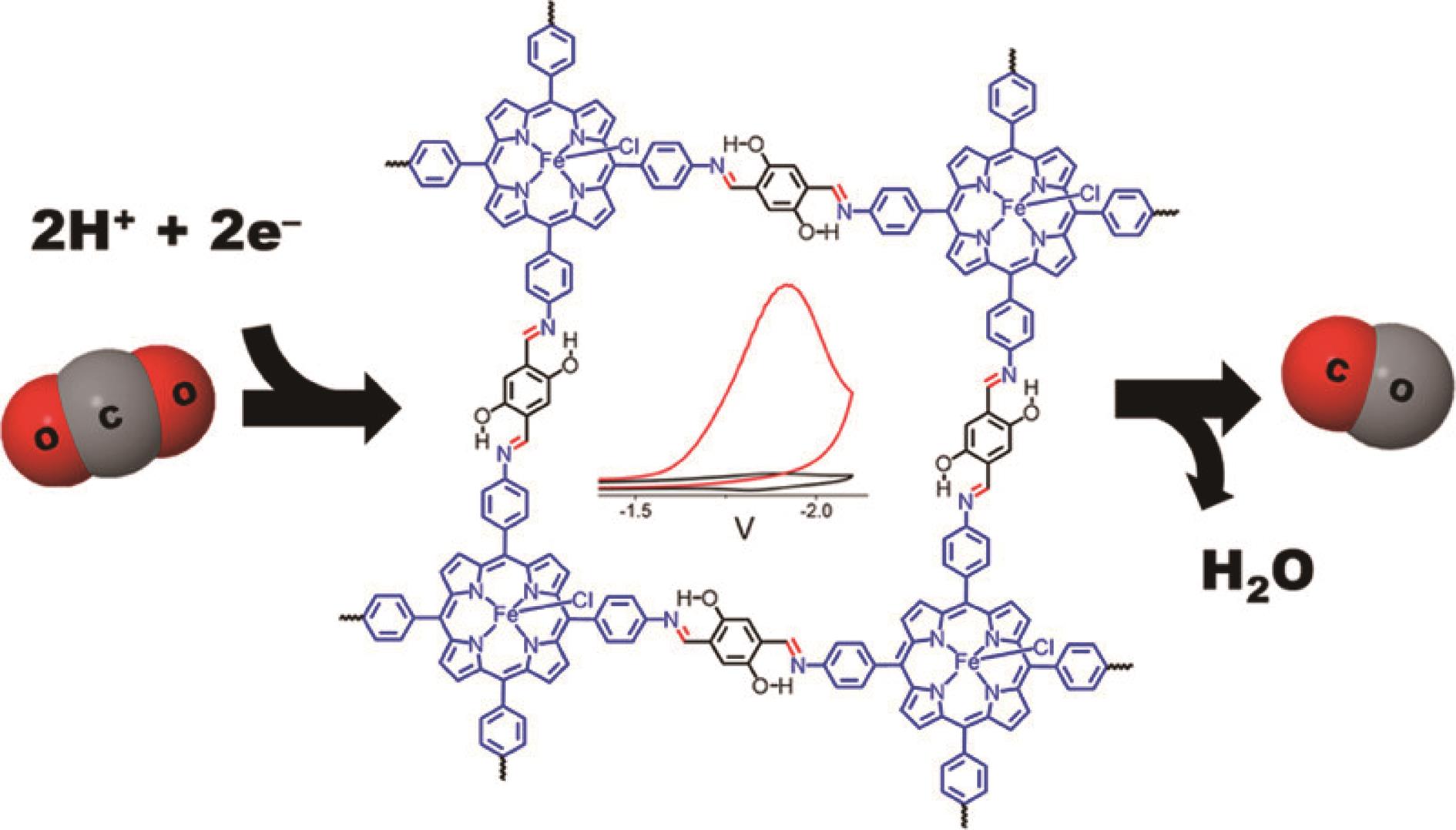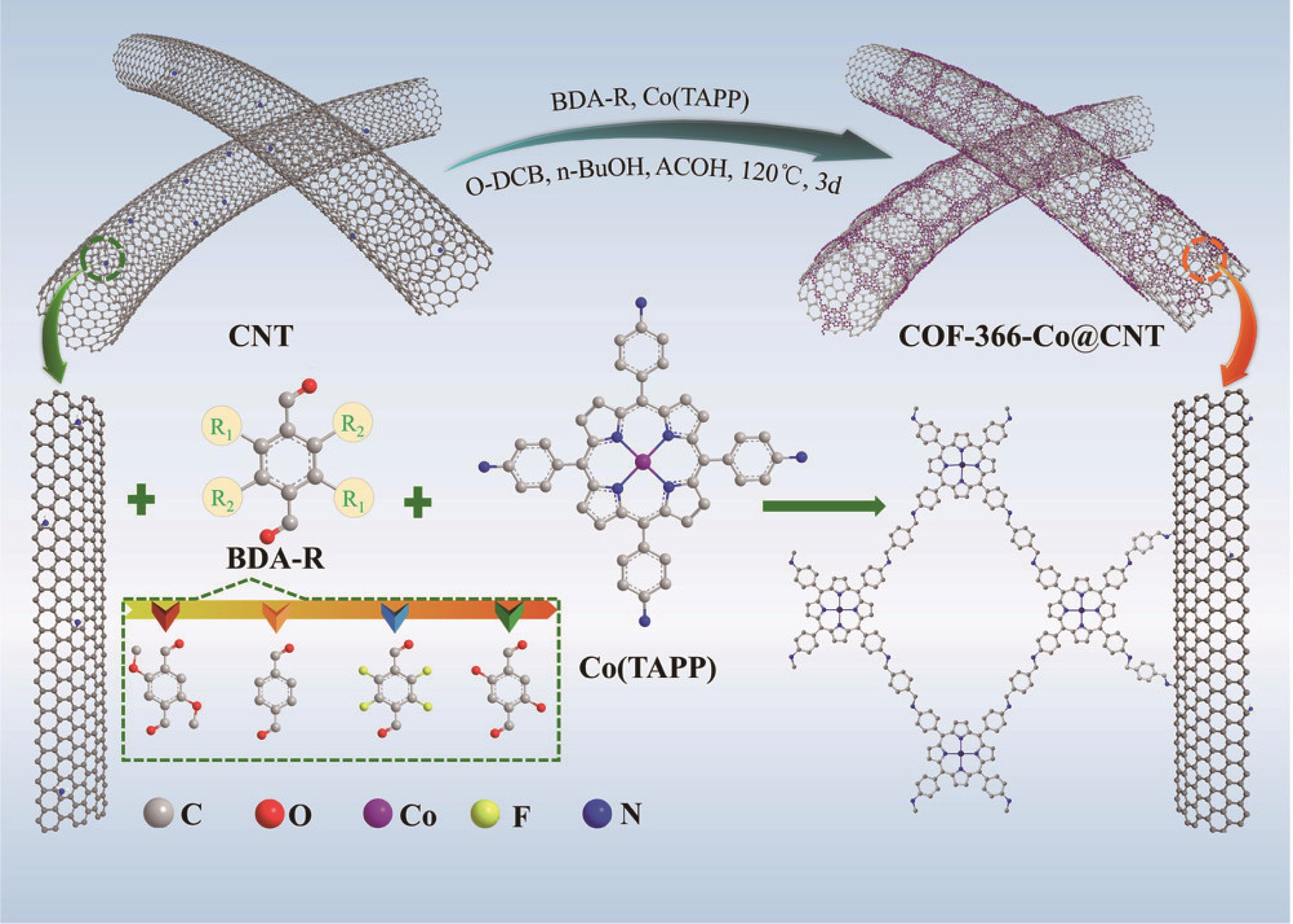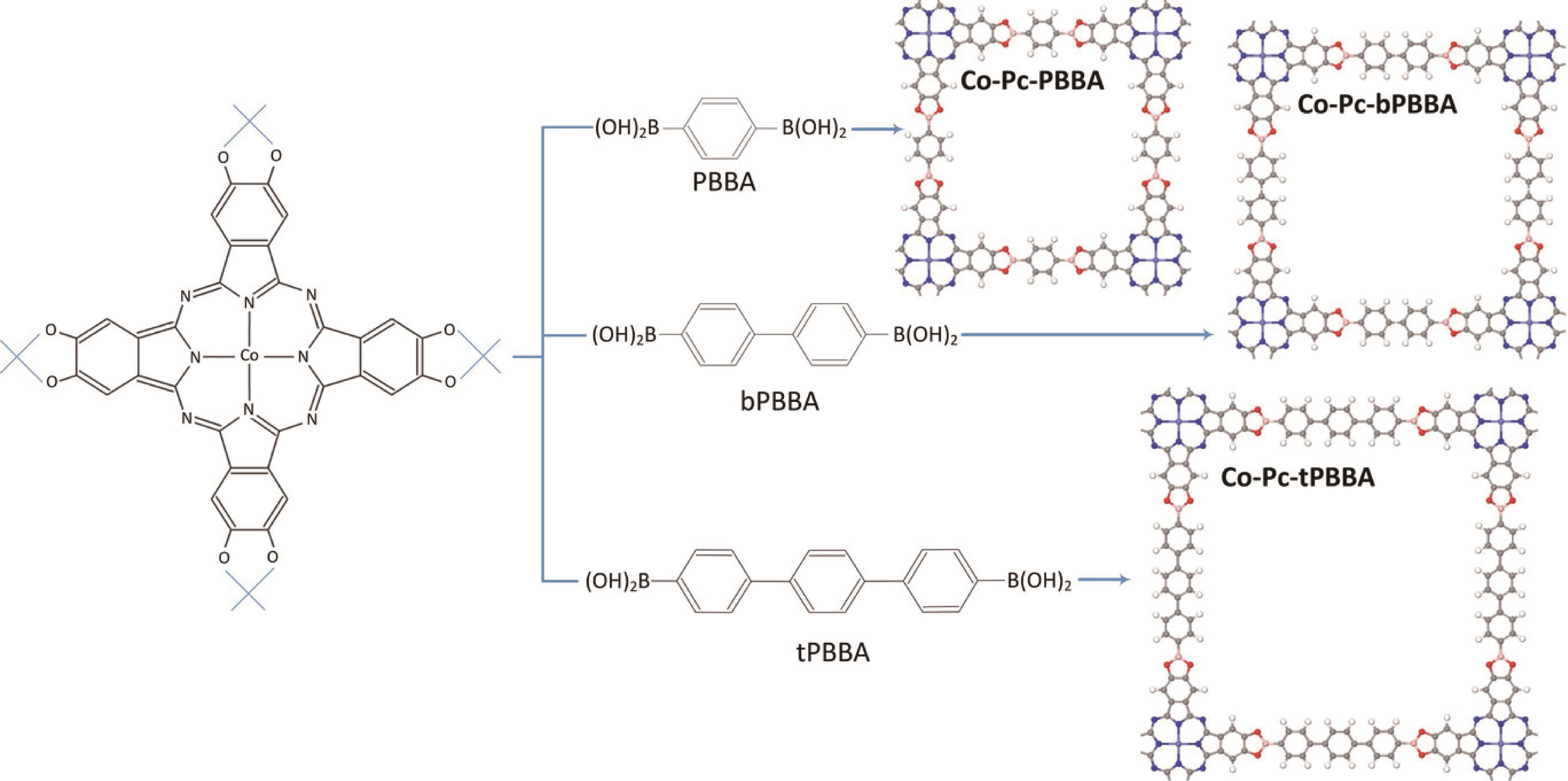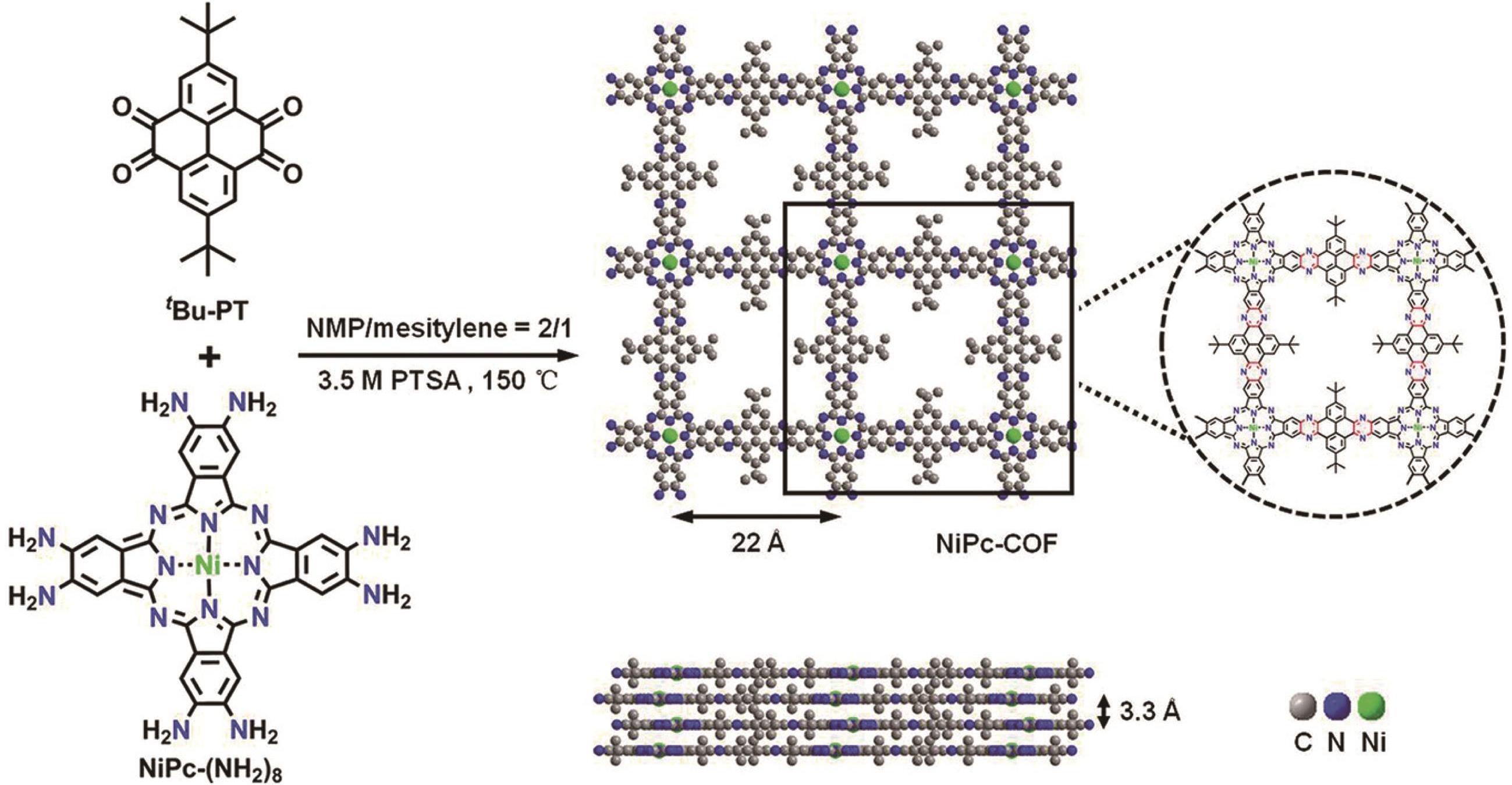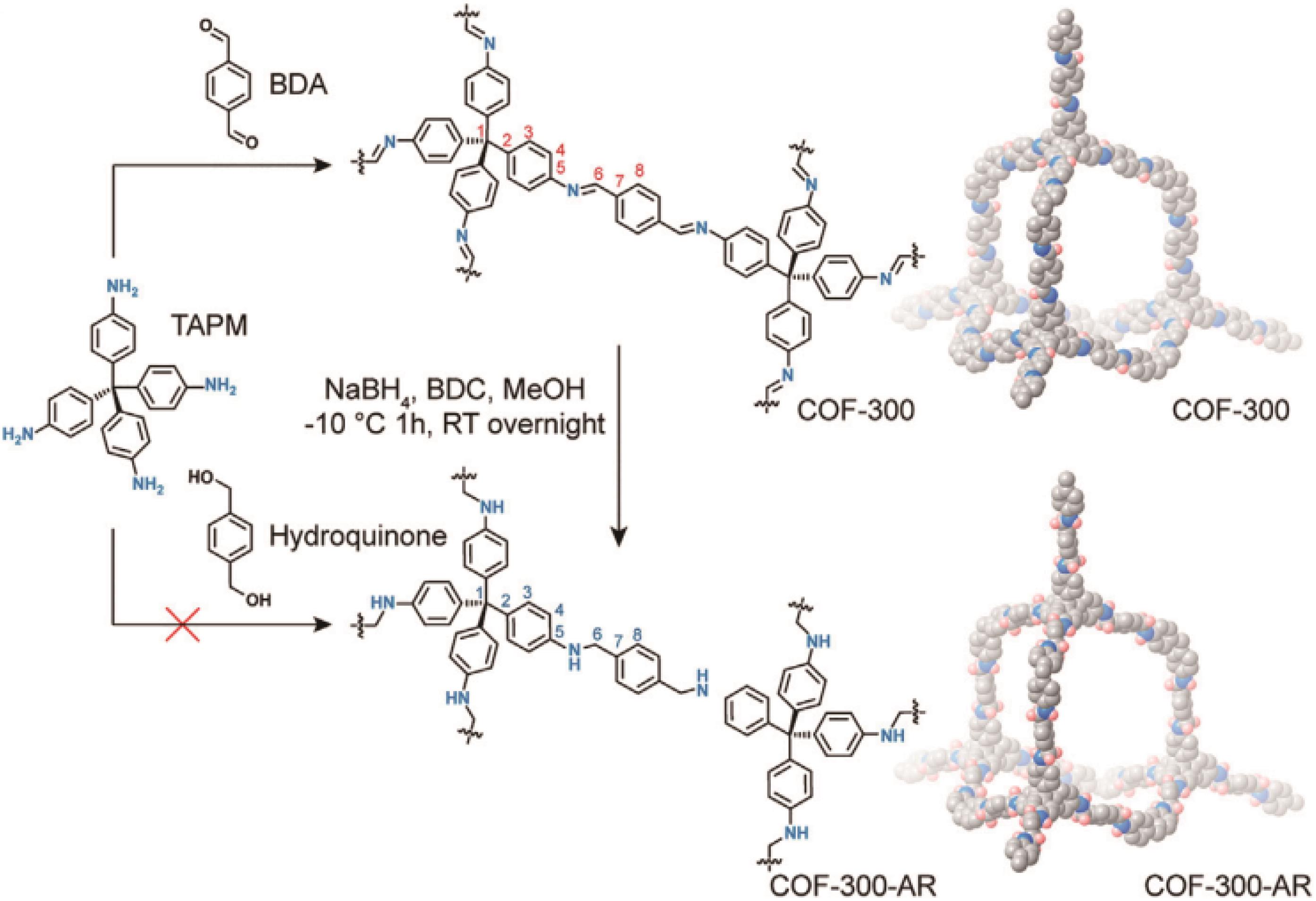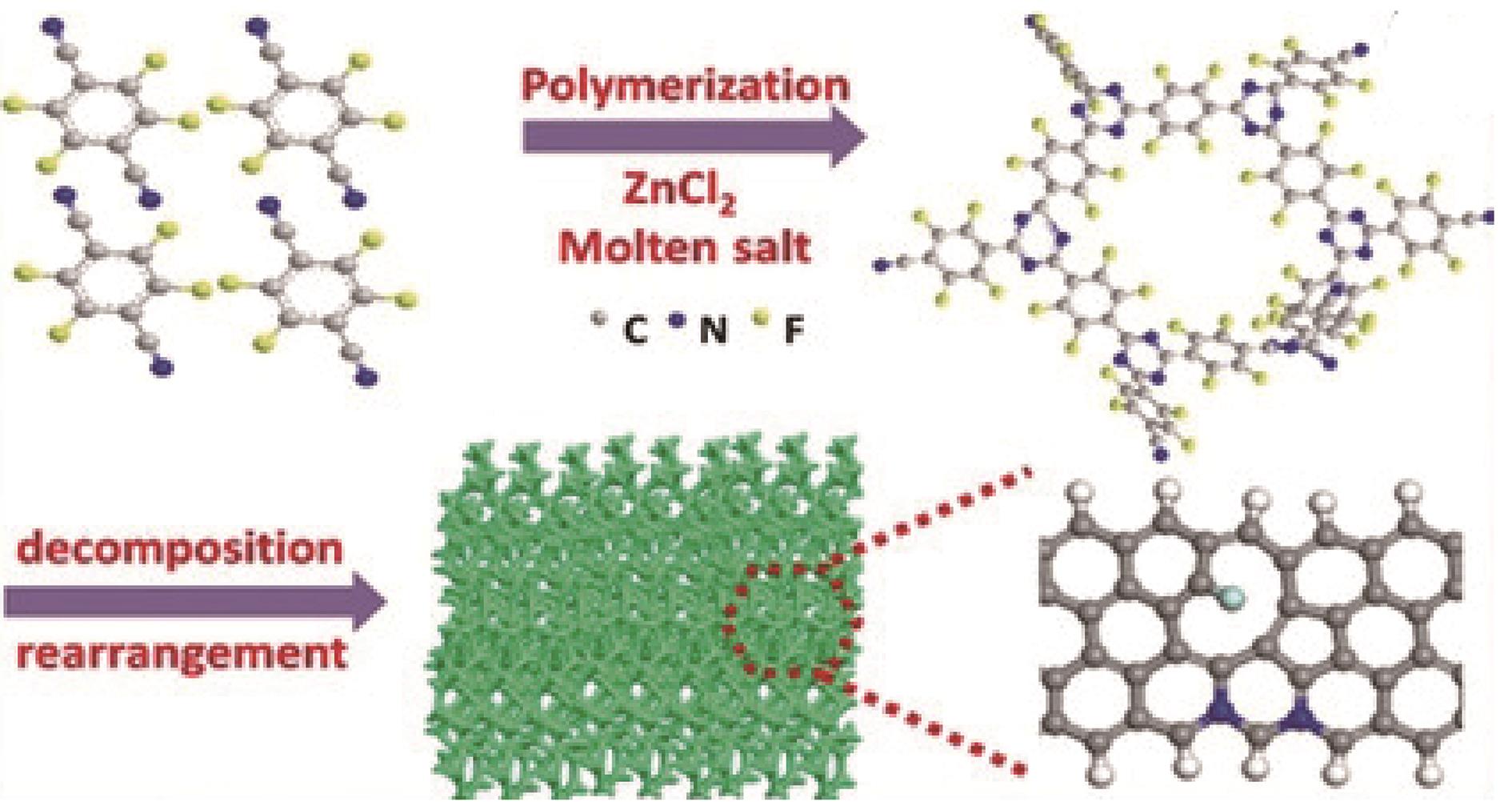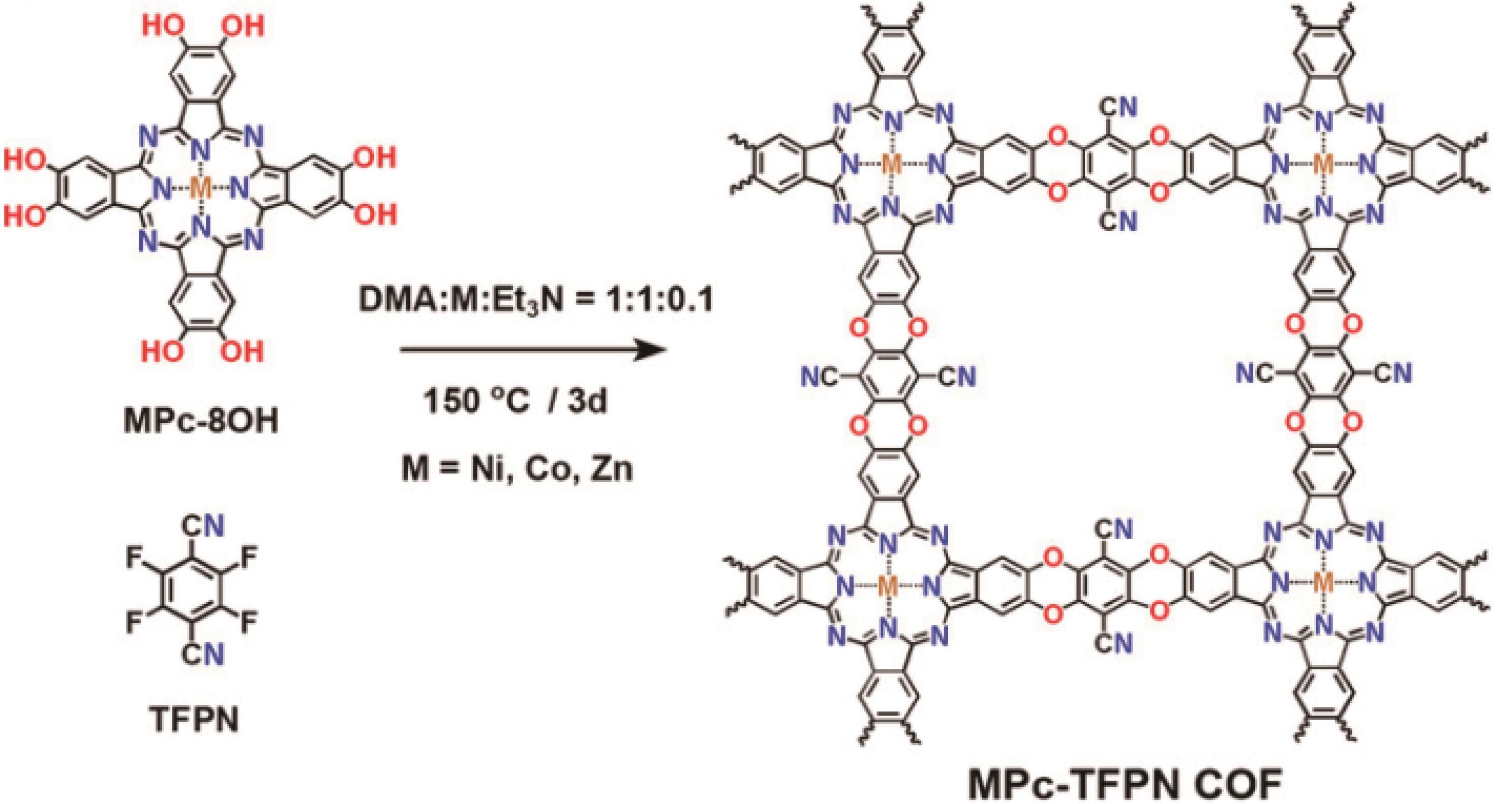
Chinese Journal of Applied Chemistry ›› 2022, Vol. 39 ›› Issue (4): 559-584.DOI: 10.19894/j.issn.1000-0518.210439
• Review • Previous Articles Next Articles
Covalent Organic Framework Materials for Photo/ Electrocatalytic Carbon Dioxide Reduction
Lin-Jie SHANG1, Jiang LIU1( ), Ya-Qian LAN2(
), Ya-Qian LAN2( )
)
- 1.School of Chemistry and Materials Science,Nanjing Normal University,Nanjing 210023,China
2.School of Chemistry,South China Normal University,Guangzhou 510006,China
-
Received:2021-08-30Accepted:2021-11-24Published:2022-04-01Online:2022-04-19 -
Contact:Jiang LIU,Ya-Qian LAN -
Supported by:the National Natural Science Foundation of China(21871141)
CLC Number:
Cite this article
Lin-Jie SHANG, Jiang LIU, Ya-Qian LAN. Covalent Organic Framework Materials for Photo/ Electrocatalytic Carbon Dioxide Reduction[J]. Chinese Journal of Applied Chemistry, 2022, 39(4): 559-584.
share this article
Add to citation manager EndNote|Ris|BibTeX
URL: http://yyhx.ciac.jl.cn/EN/10.19894/j.issn.1000-0518.210439
序号 No. | 化学反应 Chemical reactions | 氧化还原电势/V(vs NHE) Oxidation?reduction potential/V(vs NHE) |
|---|---|---|
| (1) | CO2 +2H+ +2e- → CO+H2O | -0.53 |
| (2) | CO2+2H++2e- → HCOOH | -0.61 |
| (3) | CO2+4H++4e- → HCHO+H2O | -0.48 |
| (4) | CO2+4H++4e- → C+2H2O | -0.20 |
| (5) | CO2+6H++6e- → CH3OH+H2O | -0.38 |
| (6) | CO2+8H++8e- → CH4+2H2O | -0.24 |
| (7) | 2CO2 + 12H++12e- → C2H5OH+3H2O | -0.33 |
| (8) | 2CO2+12H++12e- → C2H4+4H2O | -0.34 |
| (9) | 2CO2+14H++14e- → C2H6+4H2O | -0.27 |
| (10) | 3CO2+18H++18e- → C3H7OH+5H2O | -0.32 |
Table 1 The main products of CO2 reduction in H2O and the corresponding reduction potentials
序号 No. | 化学反应 Chemical reactions | 氧化还原电势/V(vs NHE) Oxidation?reduction potential/V(vs NHE) |
|---|---|---|
| (1) | CO2 +2H+ +2e- → CO+H2O | -0.53 |
| (2) | CO2+2H++2e- → HCOOH | -0.61 |
| (3) | CO2+4H++4e- → HCHO+H2O | -0.48 |
| (4) | CO2+4H++4e- → C+2H2O | -0.20 |
| (5) | CO2+6H++6e- → CH3OH+H2O | -0.38 |
| (6) | CO2+8H++8e- → CH4+2H2O | -0.24 |
| (7) | 2CO2 + 12H++12e- → C2H5OH+3H2O | -0.33 |
| (8) | 2CO2+12H++12e- → C2H4+4H2O | -0.34 |
| (9) | 2CO2+14H++14e- → C2H6+4H2O | -0.27 |
| (10) | 3CO2+18H++18e- → C3H7OH+5H2O | -0.32 |
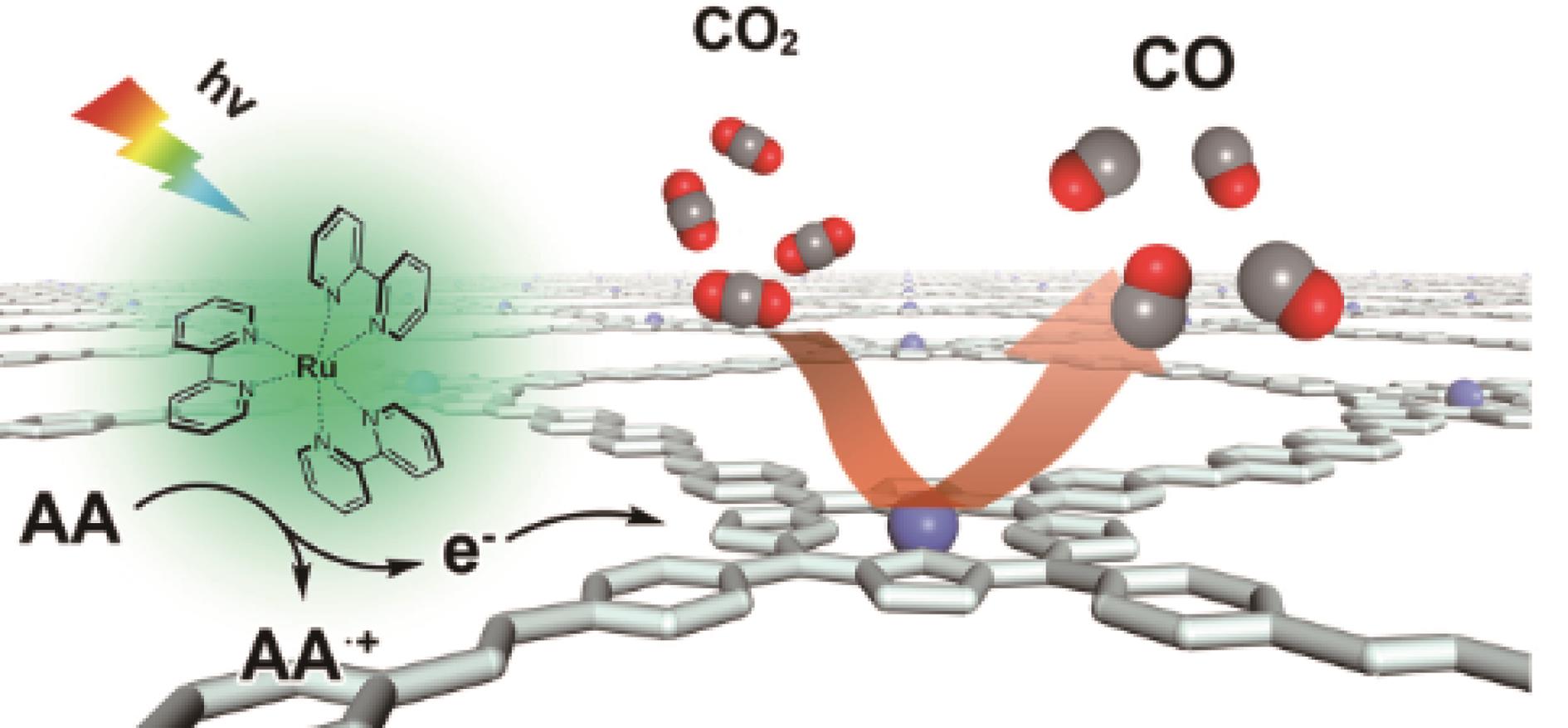
Fig.3 The photocatalytic conversion of CO2 into CO over COF-367-Co NSs under visible-light irradiation with [Ru(bpy)3]2+ as the photosensitizer and AA as the electron donor[45]
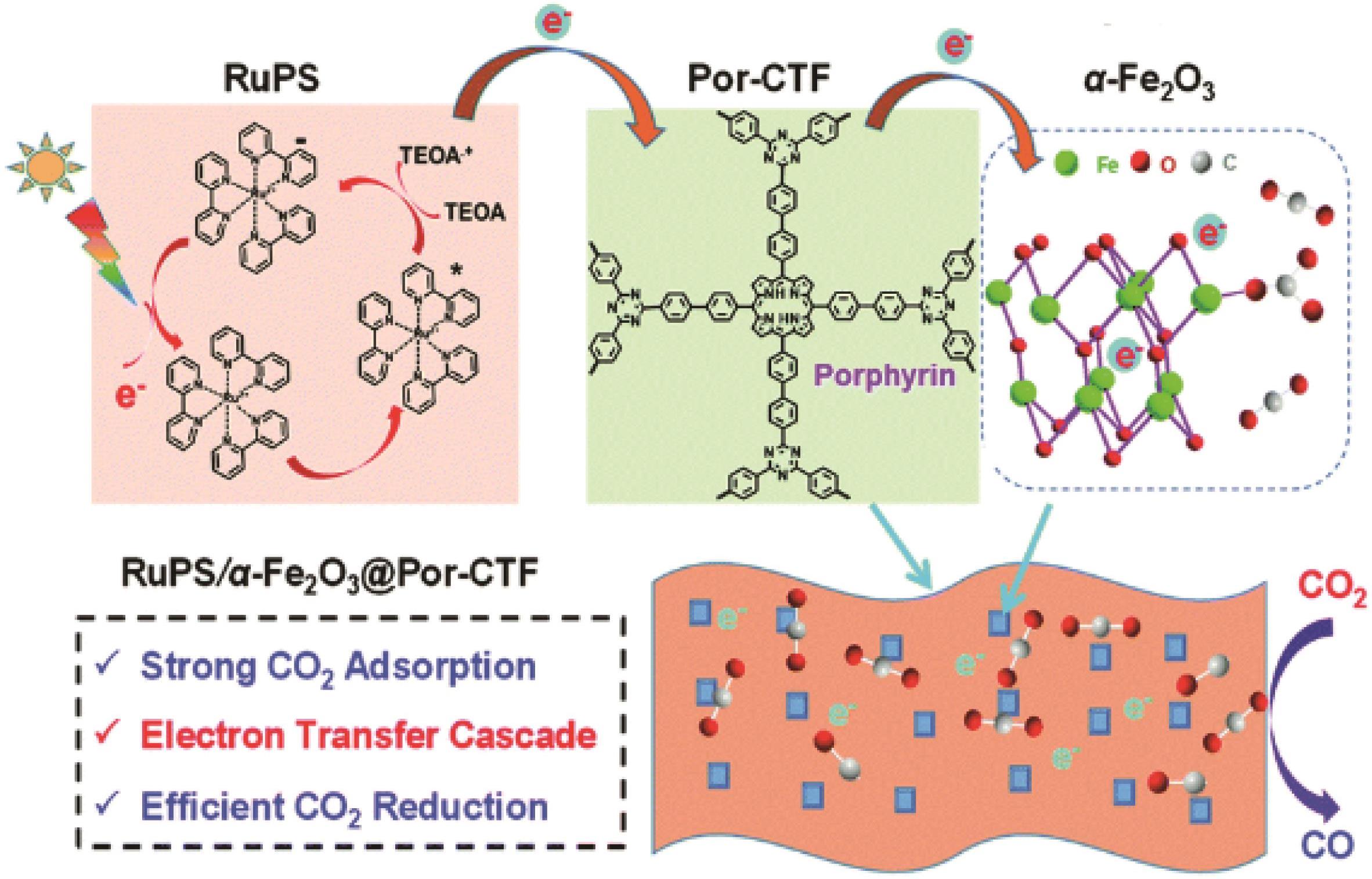
Fig.10 Proposed mechanism for the photochemical reaction comprising an electron transfer relay process with Por-CTF as the relay facilitator for carbon dioxide reduction in a ternary hybrid system[54]

Fig.16 Schematic diagram for the photocatalytic reduction of CO2 over TpBD-X [X=—H2, —(CH3)2, —(OCH3)2 and —(NO2)2] upon visible-light irradiation[60]
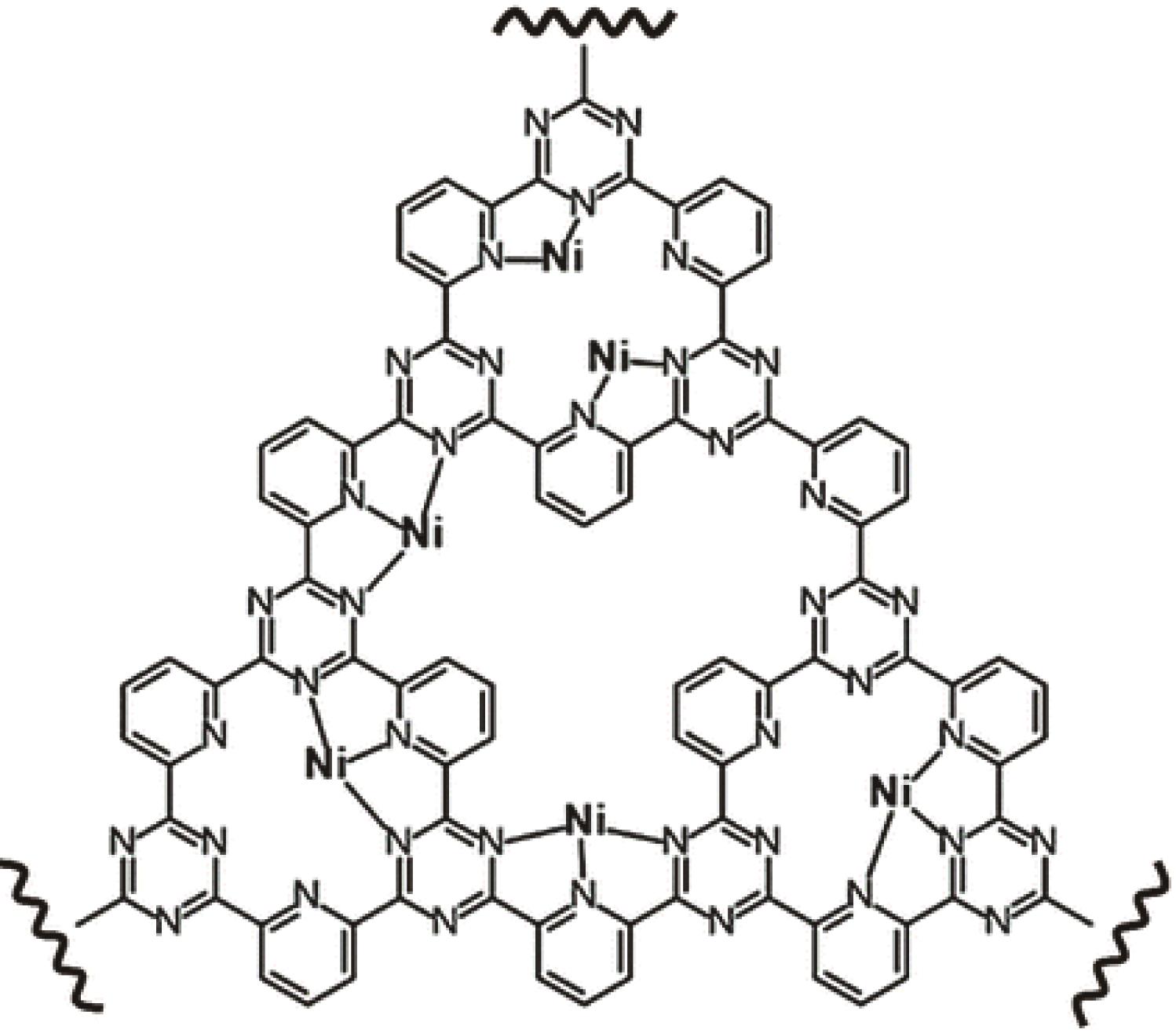
Fig.17 An illustration showing the Ni sites in Ni-CTF (weakly adsorbed molecules in electrolyte, such as water and ethanol used for the preparation of electrode, are not shown for clarity)[62]
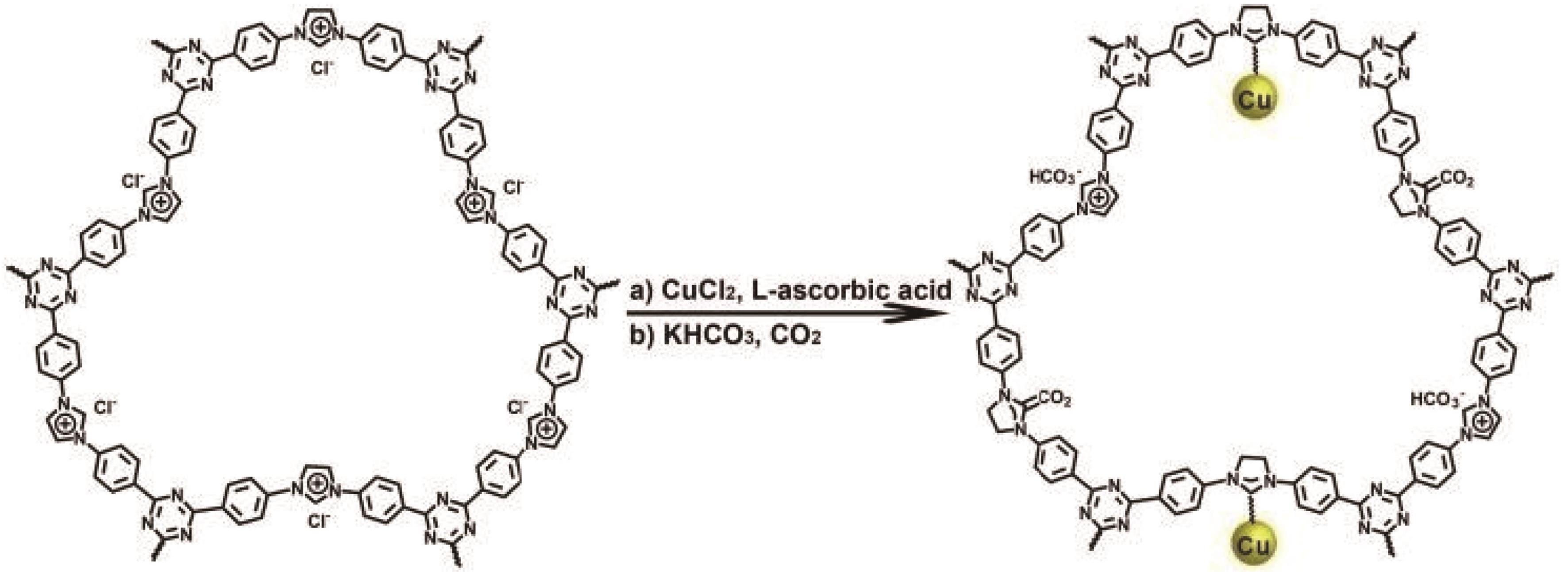
Fig.18 Schematic representation of the preparation of Cu/ICTF and its transformation in CO2RR conditions: CO2-saturated electrolyte containing a KHCO3 (0.1 mol/L) and KCl (0.1 mol/L) solution[63]
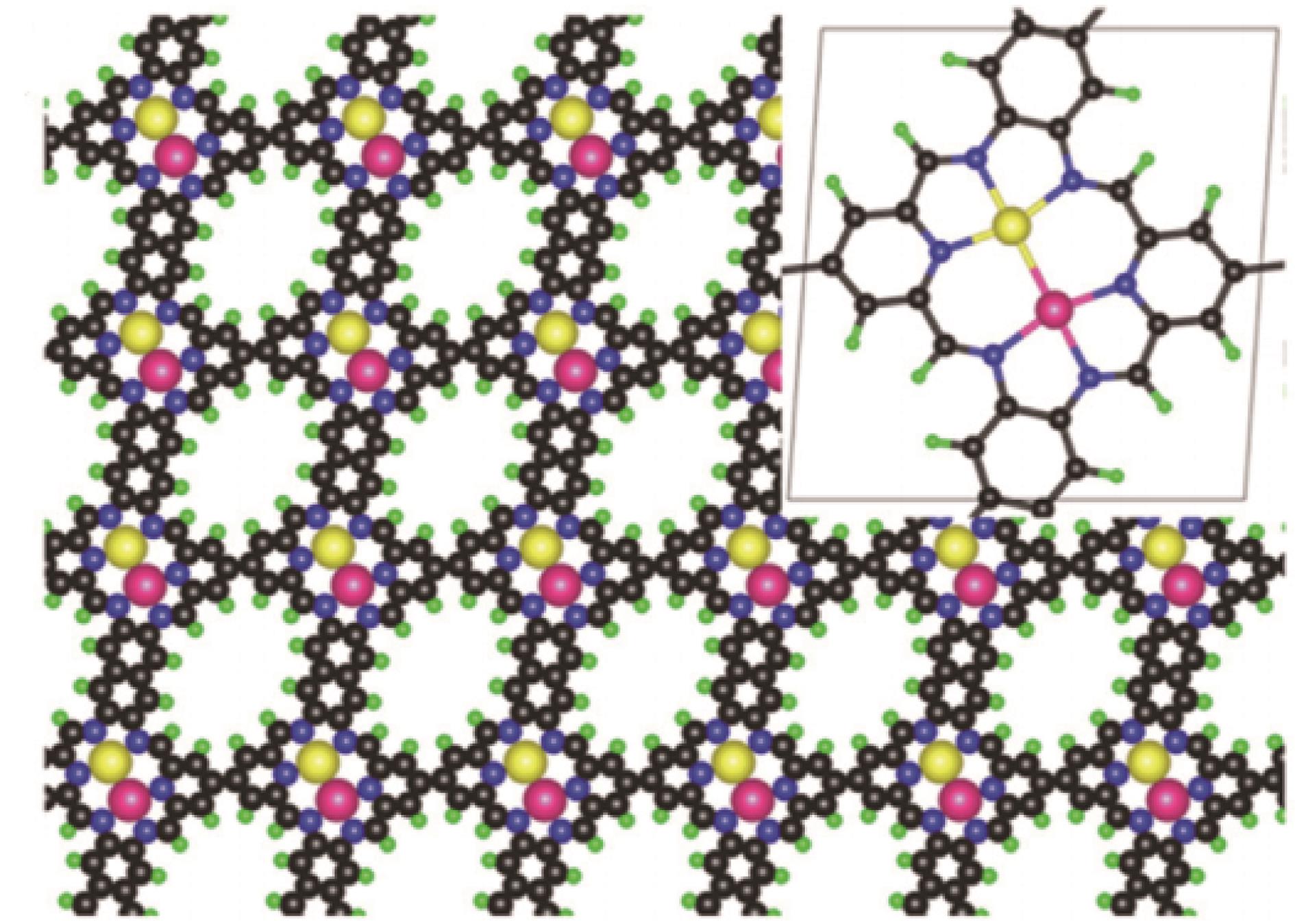
Fig.28 Schematic diagram of BAC-COFs structure (the inset in the upper right corner is a “M1/M2-N6” catalytic unit)[78]The black, blue, green, yellow and pink colors represent C, N, H, M1 and M2, respectively
| 1 | GHADIKOLAEI S S C. An enviroeconomic review of the solar PV cells cooling technology effect on the CO2 emission reduction[J]. Sol Energy, 2021, 216: 468-492. |
| 2 | ANDERSON T R, HAWKINS E, JONES P D. CO2, the greenhouse effect and global warming: from the pioneering work of arrhenius and callendar to today's earth system models[J]. Endeavour, 2016, 40(3): 178-187. |
| 3 | ZHANG L, ZHAO Z J, GONG J L. Nanostructured materials for heterogeneous electrocatalytic CO2 reduction and related reaction mechanisms[J]. Angew Chem Int Ed, 2017, 56(38): 11326-11353. |
| 4 | LI J D, ZHAO D N, LIU J Q, et al. Covalent organic frameworks: a promising materials platform for photocatalytic CO2 reductions[J]. Molecules, 2020, 25(10): 2425. |
| 5 | MORADI M, KHORASHEH F, LARIMI A. Pt nanoparticles decorated Bi-doped TiO2 as an efficient photocatalyst for CO2 photo-reduction into CH4[J]. Sol Energy, 2020, 211: 100-110. |
| 6 | CHENG L J, LIU L Q, WANG D F, et al. Synthesis of bismuth molybdate photocatalysts for CO2 photo-reduction[J]. J CO2 UTIL, 2019, 29: 196-204. |
| 7 | ZHAO S L, QIN Y, GUO T, et al. SnS nanoparticles grown on Sn-atom-modified N,S-codoped mesoporous carbon nanosheets as electrocatalysts for CO2 reduction to formate[J]. ACS Appl Nano Mater, 2021, 4(2): 2257-2264. |
| 8 | CUI X, LEI S, WANG A C, et al. Emerging covalent organic frameworks tailored materials for electrocatalysis[J]. Nano Energy, 2020, 70: 104525. |
| 9 | CHANG X X, WANG T, GONG J L. CO2 photo-reduction: insights into CO2 activation and reaction on surfaces of photocatalysts[J]. Energy Environ Sci, 2016, 9(7): 2177-2196. |
| 10 | VU N N, KALIAGUINE S, DO T O. Critical aspects and recent advances in structural engineering of photocatalysts for sunlight-driven photocatalytic reduction of CO2 into fuels[J]. Adv Funct Mater, 2019, 29(31): 1901825. |
| 11 | JIN H Y, GUO C X, LIU X, et al. Emerging two-dimensional nanomaterials for electrocatalysis[J]. Chem Rev, 2018, 118(13): 6337-6408. |
| 12 | SCHLOGL R. Heterogeneous catalysis[J]. Angew Chem Int Ed, 2015, 54(11): 3465-3520. |
| 13 | ZHU D D, LIU J L, QIAO S Z. Recent advances in inorganic heterogeneous electrocatalysts for reduction of carbon dioxide[J]. Adv Mater, 2016, 28(18): 3423-3452. |
| 14 | SAMANTA S, SRIVASTAVA R. Catalytic conversion of CO2 to chemicals and fuels: the collective thermocatalytic/photocatalytic/electrocatalytic approach with graphitic carbon nitride[J]. Mater Adv, 2020, 1(6): 1506-1545. |
| 15 | WANG G X, CHEN J X, DING Y C, et al. Electrocatalysis for CO2 conversion: from fundamentals to value-added products[J]. Chem Soc Rev, 2021, 50(8): 4993-5061. |
| 16 | DAS S, PÉREZ-RAMÍREZ J, GONG J L, et al. Core-shell structured catalysts for thermocatalytic, photocatalytic, and electrocatalytic conversion of CO2[J]. Chem Soc Rev, 2020, 49(10): 2937-3004. |
| 17 | LI X, LIU H L, LUO D L, et al. Adsorption of CO2 on heterostructure CdS(Bi2S3)/TiO2 nanotube photocatalysts and their photocatalytic activities in the reduction of CO2 to methanol under visible light irradiation[J]. Chem Eng J, 2012, 180: 151-158. |
| 18 | VU N N, KALIAGUINE S, DO T O. Synthesis of g-C3N4/CdS nanocomposite with chemically bonded interface for enhanced sunlight-driven CO2 photoreduction[J]. ACS Appl Energy Mater, 2020, 3(7): 6422-6433. |
| 19 | REÑONES BRASA P, COLLADO L, IGLESIAS-JUEZ A, et al. Silver-gold bimetal loaded TiO2 photocatalysts for CO2 reduction[J]. Ind Eng Chem Res, 2020, 59(20): 9440-9450. |
| 20 | HABISREUTINGER S N, SCHMIDT-MENDE L, STOLARCZYK J K. Photocatalytic reduction of CO2 on TiO2 and other semiconductors[J]. Angew Chem Int Ed, 2013, 52(29): 7372-7408. |
| 21 | LI Y X, WEN M M, WANG Y, et al. Plasmonic hot electrons from oxygen vacancies for infrared light-driven catalytic CO2 reduction on Bi2O3- x[J]. Angew Chem Int Ed, 2021, 60(2): 910-916. |
| 22 | MÖLLER T, SCHOLTEN F, THANH T N, et al. Electrocatalytic CO2 reduction on CuOx nanocubes: tracking the evolution of chemical state, geometric structure, and catalytic selectivity using operando spectroscopy[J]. Angew Chem Int Ed, 2020, 59(41): 17974-17983. |
| 23 | LI H, SUN J W. Highly selective photocatalytic CO2 reduction to CH4 by ball-milled cubic silicon carbide nanoparticles under visible-light irradiation[J]. ACS Appl Mater Interfaces, 2021, 13(4): 5073-5078. |
| 24 | LIU Y, ZHOU W Q, TEO W L, et al. Covalent-organic-framework-based composite materials[J]. Chem, 2020, 6(12): 3172-3202. |
| 25 | BALDWIN L A, CROWE J W, PYLES D A, et al. Metalation of a mesoporous three-dimensional covalent organic framework[J]. J Am Chem Soc, 2016, 138(46): 15134-15137. |
| 26 | ZENG Y F, ZOU R Q, ZHAO Y L. Covalent organic frameworks for CO2 capture[J]. Adv Mater, 2016, 28(15): 2855-2873. |
| 27 | DALAPATI S, JIN S B, GAO J, et al. An azine-linked covalent organic framework[J]. J Am Chem Soc, 2013, 135(46): 17310-17313. |
| 28 | WANG P Y, KANG M M, SUN S M, et al. Imine-linked covalent organic framework on surface for biosensor[J]. Chin J Chem, 2014, 32(9): 838-843. |
| 29 | PENG Y W, HUANG Y, ZHU Y H, et al. Ultrathin two-dimensional covalent organic framework nanosheets: preparation and application in highly sensitive and selective DNA detection[J]. J Am Chem Soc, 2017, 139(25): 8698-8704. |
| 30 | ROTTER J M, WEINBERGER S, KAMPMANN J, et al. Covalent organic framework films through electrophoretic deposition-creating efficient morphologies for catalysis[J]. Chem Mater, 2019, 31(24): 10008-10016. |
| 31 | MA H Z, WEI M, JIN F, et al. A 2D COF with rather low exciton binding energies comparable to 3D inorganic semiconductors in the visible range for water splitting[J]. J Phys Chem C, 2019, 123(40): 24626-24633. |
| 32 | HAO W J, CHEN D, LI Y S, et al. Facile synthesis of porphyrin based covalent organic frameworks via an A2B2 monomer for highly efficient heterogeneous catalysis[J]. Chem Mater, 2019, 31(19): 8100-8105. |
| 33 | AIYAPPA H B, THOTE J, SHINDE D B, et al. Cobalt-modified covalent organic framework as a robust water oxidation electrocatalyst[J]. Chem Mater, 2016, 28(12): 4375-4379. |
| 34 | MU Z J, DING X S, CHEN Z Y, et al. Zwitterionic covalent organic frameworks as catalysts for hierarchical reduction of CO2 with amine and hydrosilane[J]. ACS Appl Mater Interfaces, 2018, 10(48): 41350-41358. |
| 35 | WU X W, HONG Y L, XU B Q, et al. Perfluoroalkyl-functionalized covalent organic frameworks with superhydrophobicity for anhydrous proton conduction[J]. J Am Chem Soc, 2020, 142(33): 14357-14364. |
| 36 | WANG W K, ZHAO W W, XU H T, et al. Fabrication of ultra-thin 2D covalent organic framework nanosheets and their application in functional electronic devices[J]. Coord Chem Rev, 2021, 429: 213616. |
| 37 | REN X H, LIAO G C, LI Z J, et al. Two-dimensional MOF and COF nanosheets for next-generation optoelectronic applications[J]. Coord Chem Rev, 2021, 435: 213781. |
| 38 | SEGURA J L, MANCHEÑO M J, ZAMORA F. Covalent organic frameworks based on Schiff-base chemistry: synthesis, properties and potential applications[J]. Chem Soc Rev, 2016, 45(20): 5635-5671. |
| 39 | WAN S, GÁNDARA F, ASANO A, et al. Covalent organic frameworks with high charge carrier mobility[J]. Chem Mater, 2011, 23(18): 4094-4097. |
| 40 | YADAV R K, KUMAR A, PARK N J, et al. A highly efficient covalent organic framework film photocatalyst for selective solar fuel production from CO2[J]. J Mater Chem A, 2016, 4(24): 9413-9418. |
| 41 | SINGH S, AGGARWAL A, BHUPATHIRAJU N V S D K, et al. Glycosylated porphyrins phthalocyanines, and other porphyrinoids for diagnostics and therapeutics[J]. Chem Rev, 2015, 115(18): 10261-10306. |
| 42 | HAWECKER J, LEHN J M, ZIESSEL R. Efficient photochemical reduction of CO2 to CO by visible light irradiation of systems containing Re(bipy)(CO)3X or Ru(bipy)3 2+-Co2+ combinations as homogeneous catalysts[J]. J Chem Soc, Chem Commun, 1983, 9: 536-538. |
| 43 | KOJIMA T, HONDA T, OHKUBO K, et al. A discrete supramolecular conglomerate composed of two saddle-distorted zinc(Ⅱ)-phthalocyanine complexes and a doubly protonated porphyrin with saddle distortion undergoing efficient photoinduced electron transfer[J]. Angew Chem Int Ed, 2008, 47(35): 6712-6716. |
| 44 | LU M, LIU J, LI Q, et al. Rational design of crystalline covalent organic frameworks for efficient CO2 photoreduction with H2O[J]. Angew Chem Int Ed, 2019, 58(36): 12392-12397. |
| 45 | LIU W B, LI X K, WANG C M, et al. A scalable general synthetic approach towards ultrathin imine-linked two-dimensional covalent organic framework nanosheets for photocatalytic CO2 reduction[J]. J Am Chem Soc, 2019, 141(43): 17431-17440. |
| 46 | GONG Y N, ZHONG W H, LI Y, et al. Regulating photocatalysis by spin-state manipulation of cobalt in covalent organic frameworks[J]. J Am Chem Soc, 2020, 142(39): 16723-16731. |
| 47 | ZHONG W F, SA R J, LI L Y, et al. A covalent organic framework bearing single Ni sites as a synergistic photocatalyst for selective photoreduction of CO2 to CO[J]. J Am Chem Soc, 2019, 141(18): 7615-7621. |
| 48 | YANG S Z, HU W H, ZHANG X, et al. 2D covalent organic frameworks as intrinsic photocatalysts for visible light-driven CO2 reduction[J]. J Am Chem Soc, 2018, 140(44): 14614-14618. |
| 49 | XU R, WANG X S, ZHAO H, et al. Rhenium-modified porous covalent triazine framework for highly efficient photocatalytic carbon dioxide reduction in solid-gas system[J]. Catal Sci Technol, 2018, 8(8): 2224-2230. |
| 50 | PETZOLD D, KÖNIG B. Photocatalytic oxidative bromination of electron-rich arenes and heteroarenes by anthraquinone[J]. Adv Synth Catal, 2018, 360(4): 626-630. |
| 51 | LU M, LI Q, LIU J, et al. Installing earth-abundant metal active centers to covalent organic frameworks for efficient heterogeneous photocatalytic CO2 reduction[J]. Appl Catal B, 2019, 254: 624-633. |
| 52 | DAS P P, CHAUDHARY V, AHMAD F, et al. Effect of nanotoxicity and enhancement in performance of polymer composites using nanofillers: a state-of-the-art review[J]. Polym Composite, 2021, 42(5): 2152-2170. |
| 53 | BI J H, XU B, SUN L, et al. A cobalt-modified covalent triazine-based framework as an efficient cocatalyst for visible-light-driven photocatalytic CO2 reduction[J]. ChemPlusChem, 2019, 84(8): 1149-1154. |
| 54 | ZHANG S Q, WANG S Y, GUO L P, et al. An artificial photosynthesis system comprising a covalent triazine framework as an electron relay facilitator for photochemical carbon dioxide reduction[J]. J Mater Chem C, 2020, 8(1): 192-200. |
| 55 | ZHANG M, LU M, LANG Z L, et al. Semiconductor/covalent-organic-framework Z-scheme heterojunctions for artificial photosynthesis[J]. Angew Chem Int Ed, 2020, 59(16): 6500-6506. |
| 56 | WANG L J, WANG R L, ZHANG X, et al. Improved photoreduction of CO2 with water by tuning the valence band of covalent organic frameworks[J]. ChemSusChem, 2020, 13(11): 2973-2980. |
| 57 | LEI K, WANG D, YE L Q, et al. A metal-free donor-acceptor covalent organic framework photocatalyst for visible-light-driven reduction of CO2 with H2O[J]. ChemSusChem, 2020, 13(7): 1725-1729. |
| 58 | ZHOU J, CUI J X, DONG M, et al. Synergetic effect of H+ adsorption and ethylene functional group of covalent organic frameworks on the CO2 photoreduction in aqueous solution[J]. Chem Commun, 2020, 56(53): 7261-7264. |
| 59 | SONG X H, WU Y F, ZHANG X Y, et al. Boosting charge carriers separation and migration efficiency via fabricating all organic van der Waals heterojunction for efficient photoreduction of CO2[J]. Chem Eng J, 2021, 408: 127292. |
| 60 | PENG L L, CHANG S Q, LIU Z L, et al. Visible-light-driven photocatalytic CO2 reduction over ketoenamine-based covalent organic frameworks: role of the host functional groups[J]. Catal Sci Technol, 2021, 11(5): 1717-1724. |
| 61 | LIN S, DIERCKS C S, ZHANG Y B, et al. Covalent organic frameworks comprising cobalt porphyrins for catalytic CO2 reduction in water[J]. Science, 2015, 349(6253): 1208-1213. |
| 62 | SU P P, IWASE K, HARADA T, et al. Covalent triazine framework modified with coordinatively-unsaturated Co or Ni atoms for CO2 electrochemical reduction[J]. Chem Sci, 2018, 9(16): 3941-3947. |
| 63 | MAO M J, ZHANG M D, MENG D L, et al. Imidazolium-functionalized cationic covalent triazine frameworks stabilized copper nanoparticles for enhanced CO2 electroreduction[J]. ChemCatChem, 2020, 12(13): 3530-3536. |
| 64 | GONG L L, WANG X W, ZHENG T, et al. Catalytic mechanism and design principle of coordinately unsaturated single metal atom-doped covalent triazine frameworks with high activity and selectivity for CO2 electroreduction[J]. J Mater Chem A, 2021, 9(6): 3555-3566. |
| 65 | HUANG Z W, HU K Q, MEI L, et al. Potassium ions induced framework interpenetration for enhancing the stability of uranium-based porphyrin MOF with visible-light-driven photocatalytic activity[J]. Inorg Chem, 2021, 60(2): 651-659. |
| 66 | DIERCKS C S, LIN S, KORNIENKO N, et al. Reticular electronic tuning of porphyrin active sites in covalent organic frameworks for electrocatalytic carbon dioxide reduction[J]. J Am Chem Soc, 2018, 140(3): 1116-1122. |
| 67 | LU C B, YANG J, WEI S C, et al. Atomic Ni anchored covalent triazine framework as high efficient electrocatalyst for carbon dioxide conversion[J]. Adv Funct Mater, 2019, 29(10): 1806884. |
| 68 | CHEUNG P L, LEE S K, KUBIAK C P. Facile solvent-free synthesis of thin iron porphyrin COFs on carbon cloth electrodes for CO2 reduction[J]. Chem Mater, 2019, 31(6): 1908-1919. |
| 69 | LU Y, ZHANG J, WEI W B, et al. Efficient carbon dioxide electroreduction over ultrathin covalent organic framework nanolayers with isolated cobalt porphyrin units[J]. ACS Appl Mater Interfaces, 2020, 12(34): 37986-37992. |
| 70 | JIANG Z, WANG Y, ZHANG X, et al. Revealing the hidden performance of metal phthalocyanines for CO2 reduction electrocatalysis by hybridization with carbon nanotubes[J]. Nano Res, 2019, 12: 2330-2334. |
| 71 | WANG M, TORBENSEN K, SALVATORE D, et al. CO2 electrochemical catalytic reduction with a highly active cobalt phthalocyanine[J]. Nat Commun, 2019, 10: 3602. |
| 72 | YAO C L, LI J C, GAO W, et al. An integrated design with new metal-functionalized covalent organic frameworks for effective electroreduction of CO2[J]. Chem-Eur J, 2018, 24(43): 11051-11058. |
| 73 | ZHANG M D, SI D H, YI J D, et al. Conductive phthalocyanine-based covalent organic framework for highly efficient electroreduction of carbon dioxide[J]. Small, 2020, 16(52): 2005254. |
| 74 | KEITH J A, GRICE K A, KUBIAK C P, et al. Elucidation of the selectivity of proton-dependent electrocatalytic CO2 reduction by fac-Re(bpy)(CO)3Cl[J]. J Am Chem Soc, 2013, 135(42): 15823-15829. |
| 75 | POPOV D A, LUNA J M, ORCHANIAN N M, et al. A 2,2'-bipyridine-containing covalent organic framework bearing rhenium(I) tricarbonyl moieties for CO2 reduction[J]. Dalton Trans, 2018, 47(48): 17450-17460. |
| 76 | JIAO J Q, LIN R, LIU S J, et al. Copper atom-pair catalyst anchored on alloy nanowires for selective and efficient electrochemical reduction of CO2[J]. Nat Chem, 2019, 11(3): 222-228. |
| 77 | JOHNSON E M, HAIGES R, MARINESCU S C. Covalent-organic frameworks composed of rhenium bipyridine and metal porphyrins: designing heterobimetallic frameworks with two distinct metal sites[J]. ACS Appl Mater Interfaces, 2018, 10(44): 37919-37927. |
| 78 | GONG L L, ZHANG D T, SHEN Y, et al. Enhancing both selectivity and activity of CO2 conversion by breaking scaling relations with bimetallic active sites anchored in covalent organic frameworks[J]. J Catal, 2020, 390: 126-134. |
| 79 | LIU H Y, CHU J, YIN Z L, et al. Covalent organic frameworks linked by amine bonding for concerted electrochemical reduction of CO2[J]. Chem, 2018, 4(7): 1696-1709. |
| 80 | WANG Y S, CHEN J X, WANG G X, et al. Perfluorinated covalent triazine framework derived hybrids for the highly selective electroconversion of carbon dioxide into methane[J]. Angew Chem Int Ed, 2018, 57(40): 13120-13124. |
| 81 | HUANG X F, SHEN Q, LIU J B, et al. A CO2 adsorption-enhanced semiconductor/metal-complex hybrid photoelectrocatalytic interface for efficient formate production[J]. Energy Environ Sci, 2016, 9(10): 3161-3171. |
| 82 | LU M, ZHANG M, LIU C G, et al. Stable dioxin-linked metallophthalocyanine covalent organic frameworks as photo-coupled electrocatalysts for CO2 reduction[J]. Angew Chem Int Ed, 2021, 60(9): 4864-4871. |
| [1] | Xue-Bo LEI, Hui-Jing LIU, He-Yu DING, Guo-Dong SHEN, Run-Jun SUN. Research Progress on Photocatalysts for Degradation of Organic Pollutants in Printing and Dyeing Wastewater [J]. Chinese Journal of Applied Chemistry, 2023, 40(5): 681-696. |
| [2] | Hao FU, Wan-Qi XIONG, Zhen WANG, Ai-Hong DUAN, Li-Ming YUAN. Covalent Organic Framework Material Derivative of Chiral Camphor Used as High Performance Liquid Chromatography Stationary Phase for Resolution of Racemates [J]. Chinese Journal of Applied Chemistry, 2022, 39(9): 1371-1381. |
| [3] | Chao ZHANG. Research Prospect of Single Atom Catalysts Towards Electrocatalytic Reduction of Carbon Dioxide [J]. Chinese Journal of Applied Chemistry, 2022, 39(6): 871-887. |
| [4] | Yan WANG, Shu-Cong ZHANG, Xing-Kun WANG, Zhi-Cheng LIU, Huan-Lei WANG, Ming-Hua HUANG. Research Progress on Transition Metal⁃Based Catalysts for Hydrogen Evolution Reaction via Seawater Electrolysis [J]. Chinese Journal of Applied Chemistry, 2022, 39(6): 927-940. |
| [5] | Jia-He WANG, Da-Yong LIU, Wei LIU, Lin WANG, Biao DONG. Research Progress on Photocatalytic Antibacterial Application of TiO2 Nano Materials [J]. Chinese Journal of Applied Chemistry, 2022, 39(4): 629-646. |
| [6] | Li-Zhi SUN, Hao LYU, Xiao-Wen MIN, Ben LIU. Mesoporous Palladium⁃Boron Alloy Nanocatalysts: Synthesis and Performance in Methanol Oxidation Electrocatalysis [J]. Chinese Journal of Applied Chemistry, 2022, 39(4): 673-684. |
| [7] | Hui LU, Jiang LI, Li-Hua WANG, Ying ZHU, Jing CHEN. Researsh Progress of Photocatalytic Applications of Atomically Precise Coinage Metal Nanoclusters [J]. Chinese Journal of Applied Chemistry, 2022, 39(11): 1652-1664. |
| [8] | Xiang-Zhi YE, Yun-Shui DENG, Yuan LIU, Yong-Liu ZHOU, Jian-Xiong HE, Chun-Rong XIONG. Glass Sphere Supported Amorphous Organotitanium Polymer to Improve the Turnover Frequency in Photocatalytic Reduction of CO2 [J]. Chinese Journal of Applied Chemistry, 2022, 39(10): 1554-1563. |
| [9] | Ying-Zi LI, Ting LIU, Si-Qi WU, Xuan FANG, Jing GAO, Shi TANG. Metallaphotoredox⁃Catalyzed O⁃Arylation of Serine [J]. Chinese Journal of Applied Chemistry, 2022, 39(10): 1610-1616. |
| [10] | YANG Yu-Ping, XU Shao-Hong, MA Guo-Yang, JIAO Li-Ming, SUN Li-Ping, XIA Ran. Synthesis of 5-Deuterated Ribavirin Derivative [J]. Chinese Journal of Applied Chemistry, 2021, 38(8): 911-916. |
| [11] | TANG Fei, DU Duo-Qin, TAN Yun-Fei, QIN Li-Xiao. Preparation and Characterization of MoO3-x Hexagonal Microrods as High-Efficiency Photocatalysts [J]. Chinese Journal of Applied Chemistry, 2021, 38(1): 92-98. |
| [12] | ZHANG Chun-Hua, ZHAO Xiao-Bo, LI Yue-Jun, SUN Da-Wei. Preparation of (BiO)2CO3-Bi-TiO2 Composite Nanofibers and Its Photocatalytic Degradation of Antibiotics [J]. Chinese Journal of Applied Chemistry, 2021, 38(1): 99-106. |
| [13] | HUANG Jieying, LIU Jianjun, ZUO Shengli, HAN Wenjing, YU Yingchun. Preparation of Ag3PO4 Quantum Dots/g-C3N4 Nanosheet Composite Photocatalysts and Its Activity for Selective Oxidation of Benzyl Alcohol [J]. Chinese Journal of Applied Chemistry, 2020, 37(9): 1030-1037. |
| [14] | BI Yipiao, GONG Xue, YANG Fa, RUAN Mingbo, SONG Ping, XU Weilin. Polyvalent MnOx/C Electrocatalyst for Highly Efficient Nitrogen Reduction Reaction [J]. Chinese Journal of Applied Chemistry, 2020, 37(9): 1048-1055. |
| [15] | MENG Yang, YANG Chan, PENG Juan. Progress in Iron, Cobalt and Nickel-Based Metal Phosphide Nano-catalysts for Hydrogen Production under Alkaline Conditions [J]. Chinese Journal of Applied Chemistry, 2020, 37(7): 733-745. |
| Viewed | ||||||
|
Full text |
|
|||||
|
Abstract |
|
|||||

